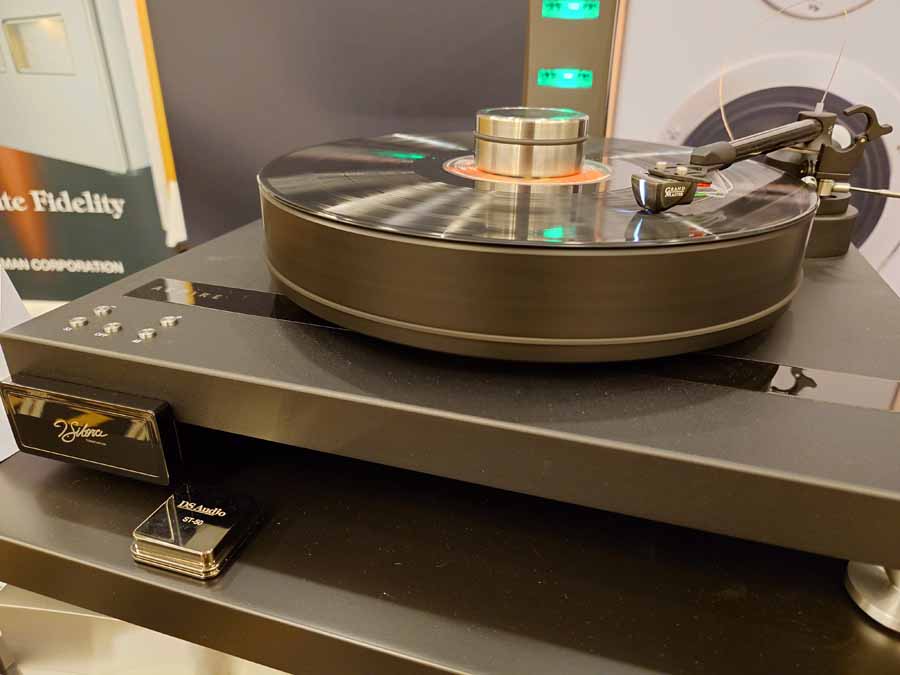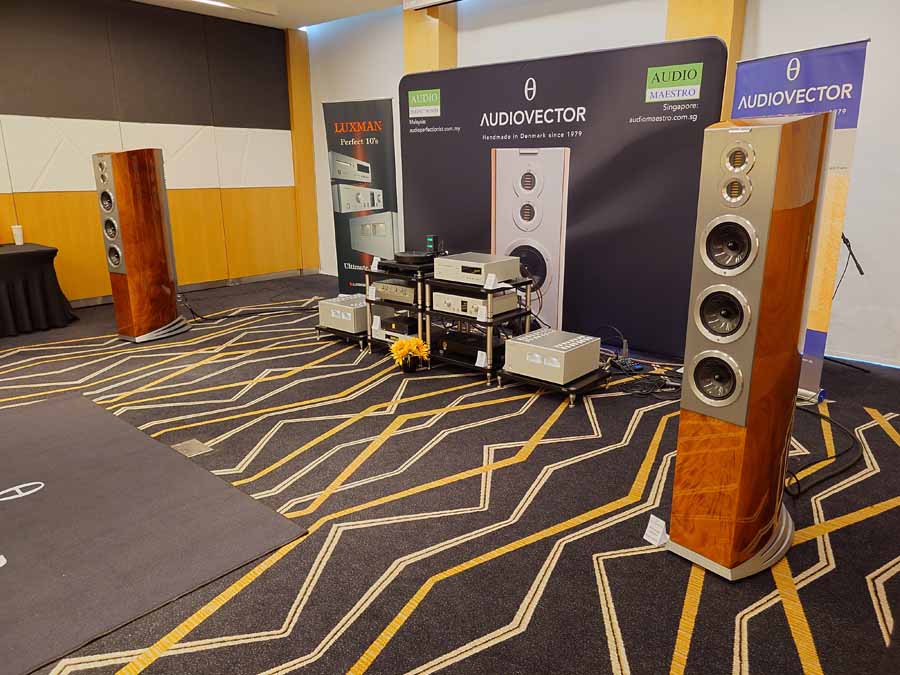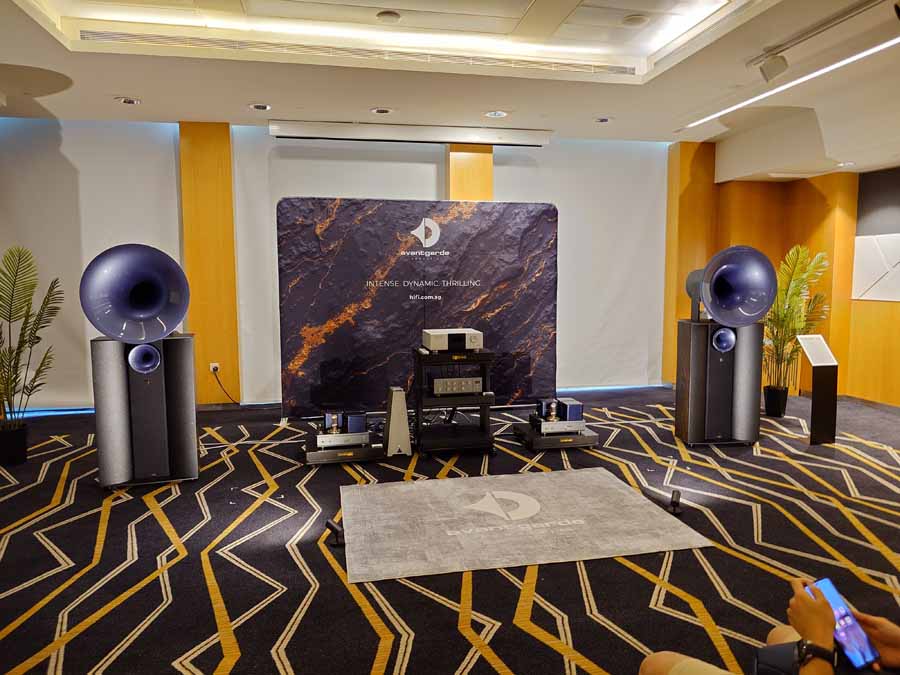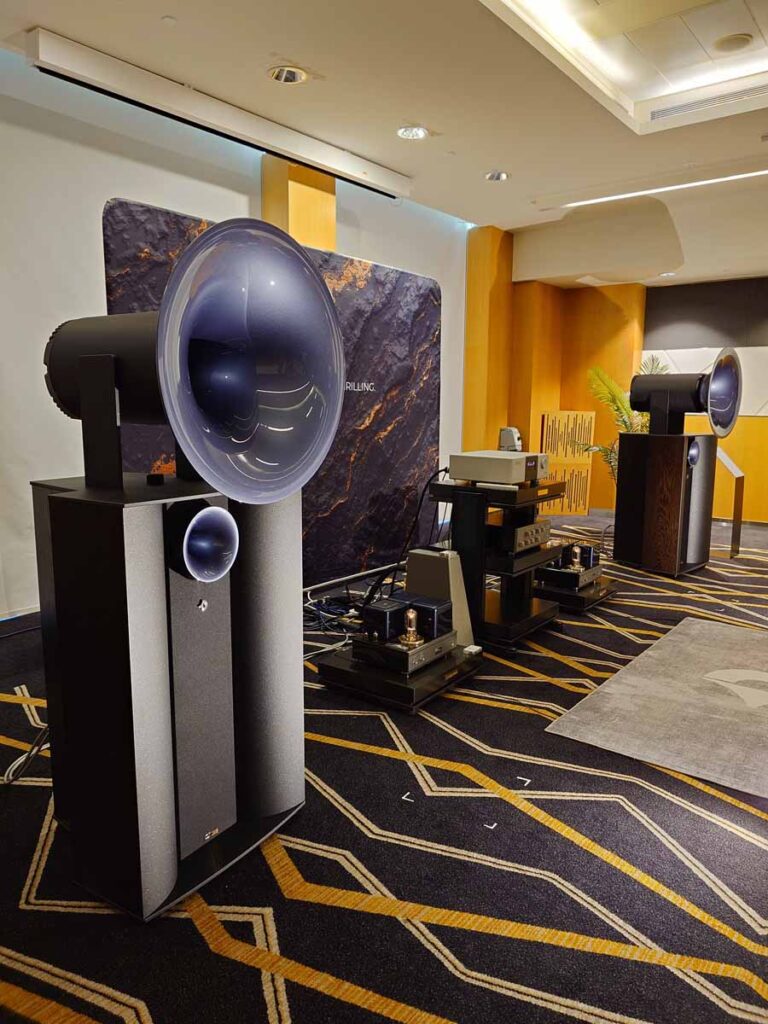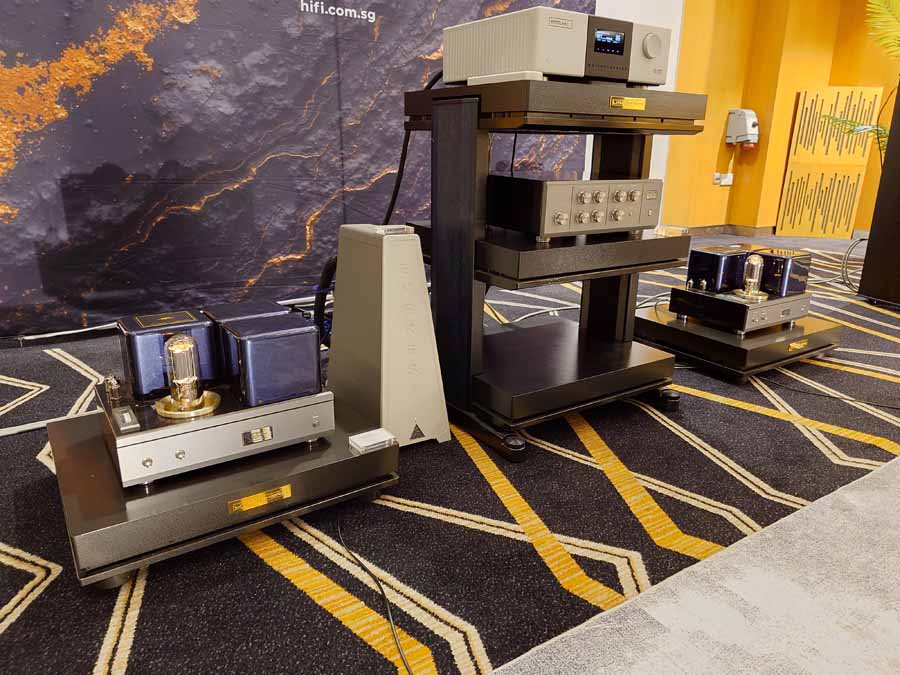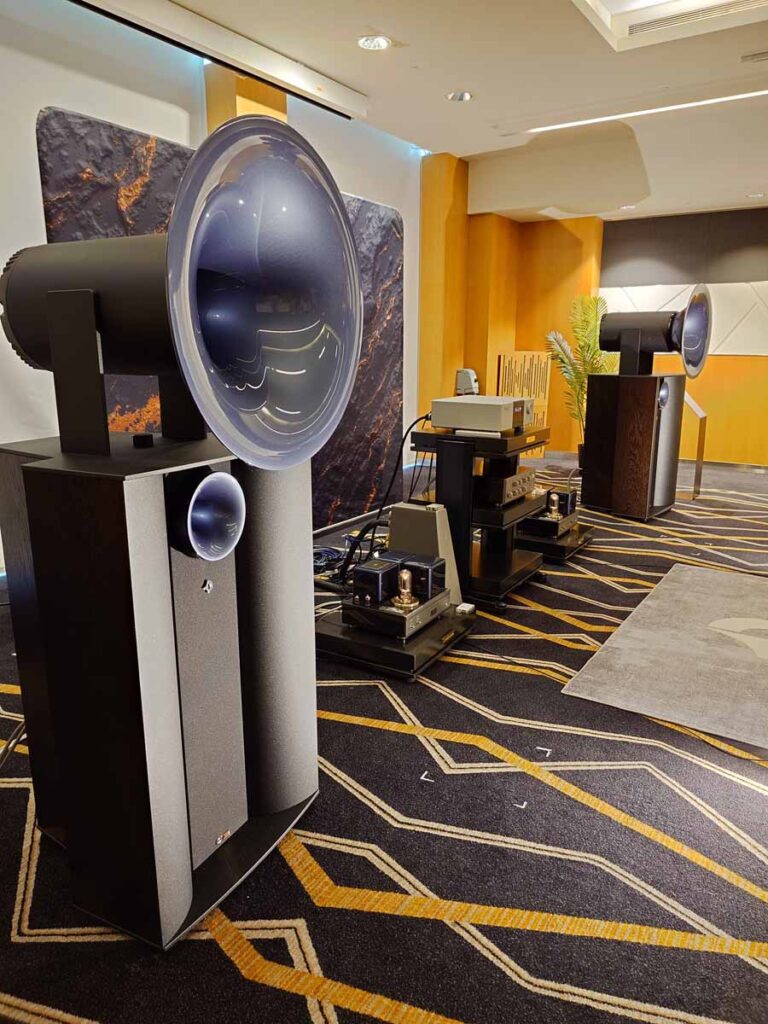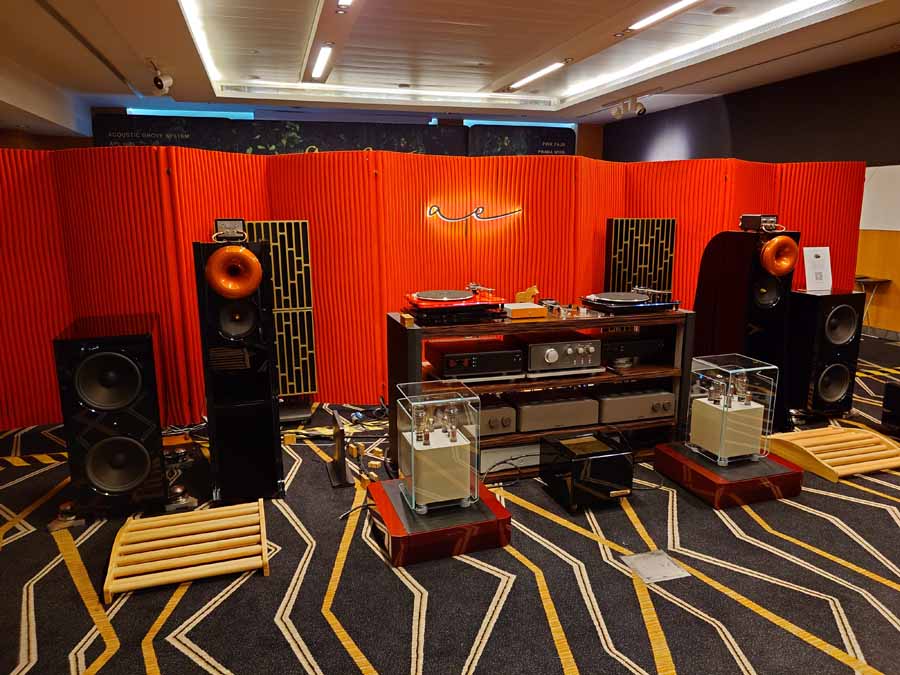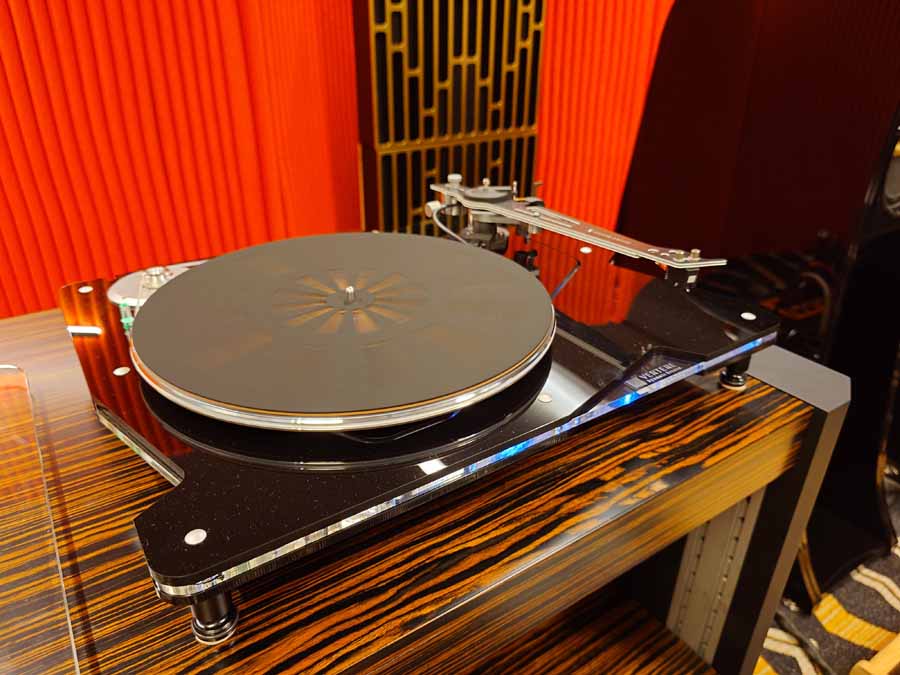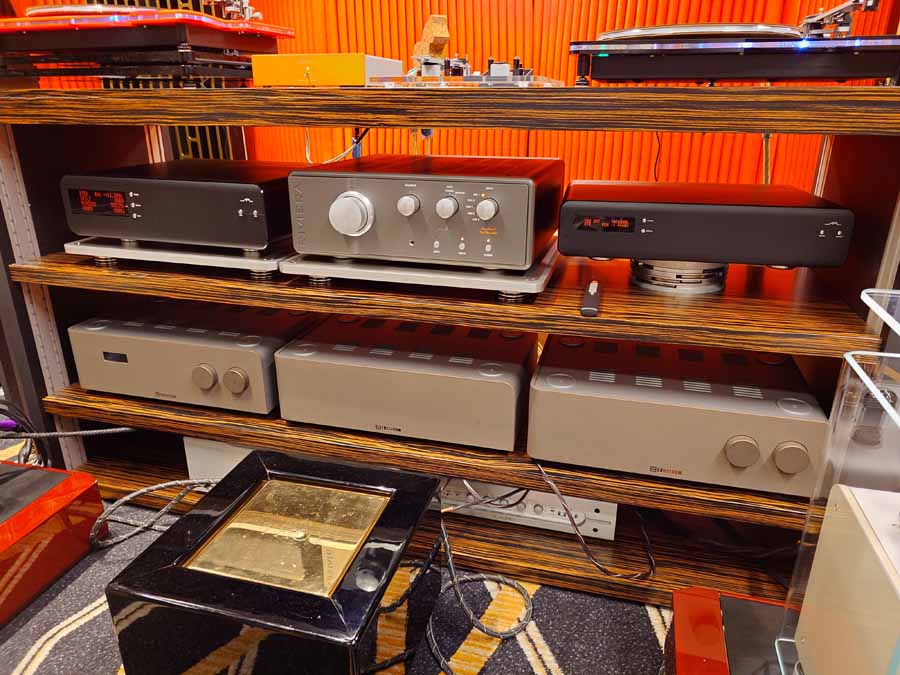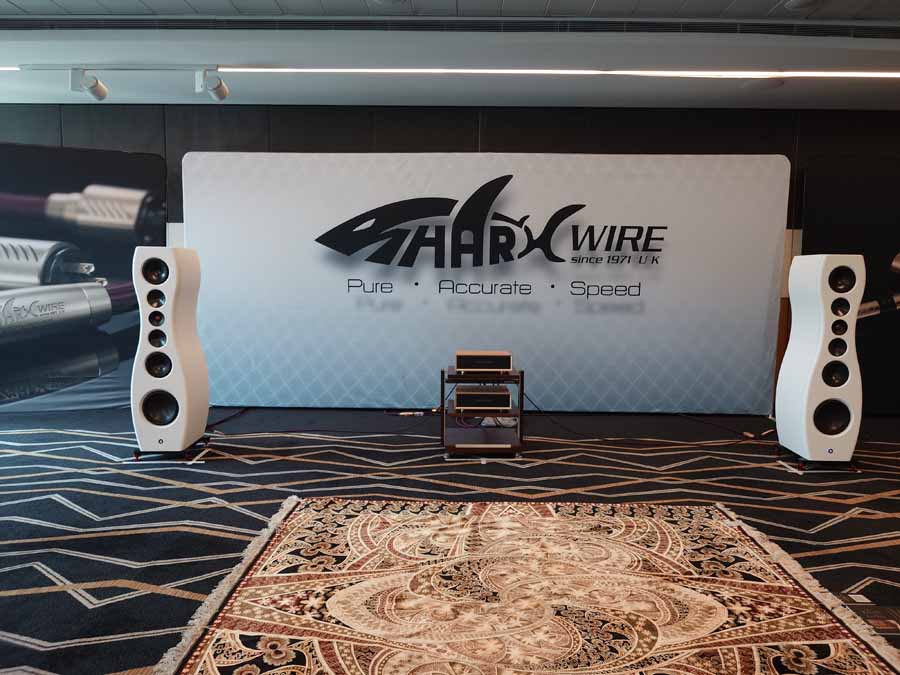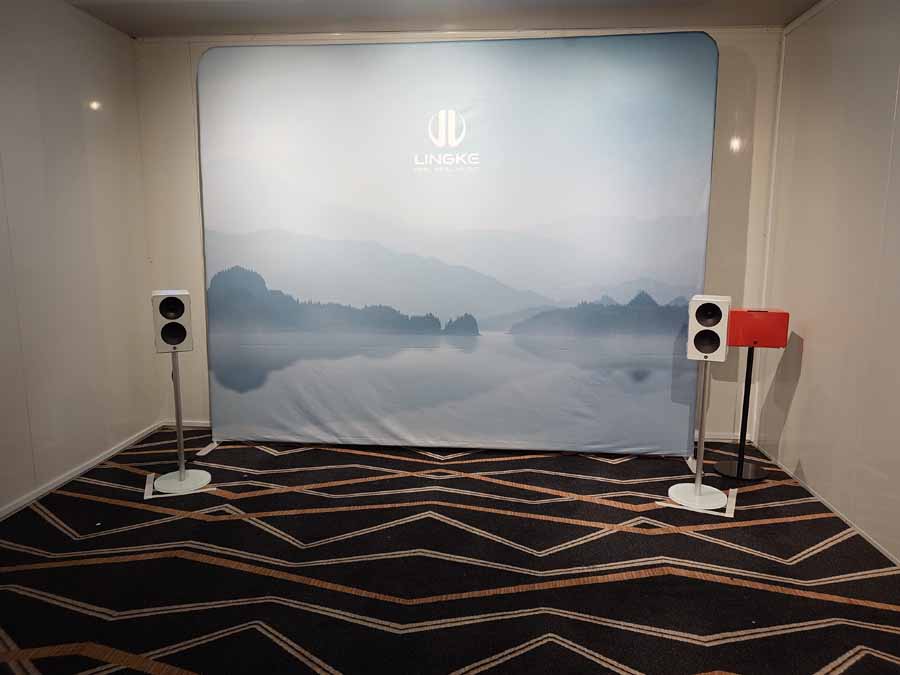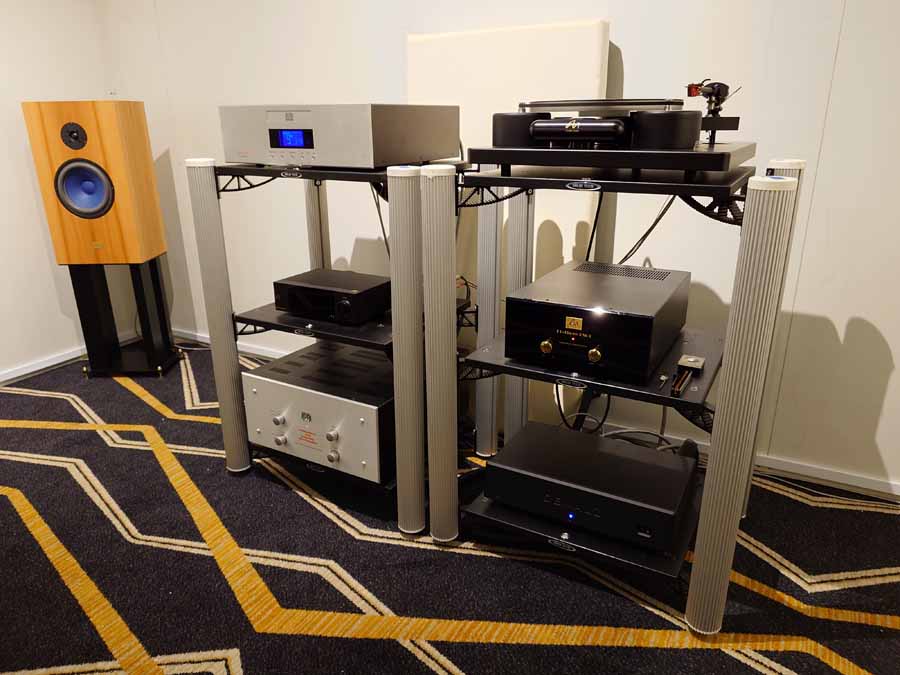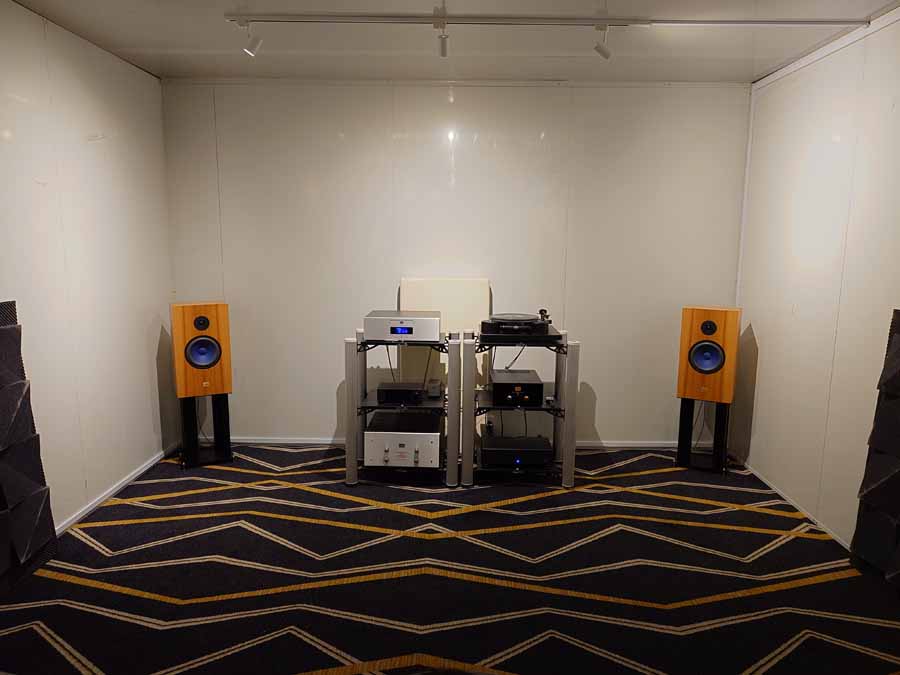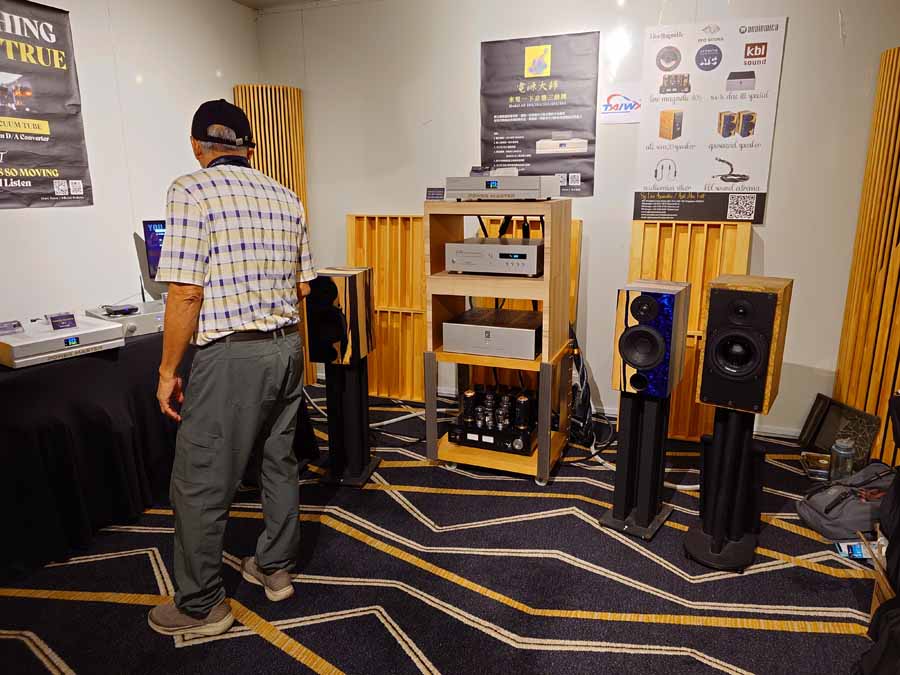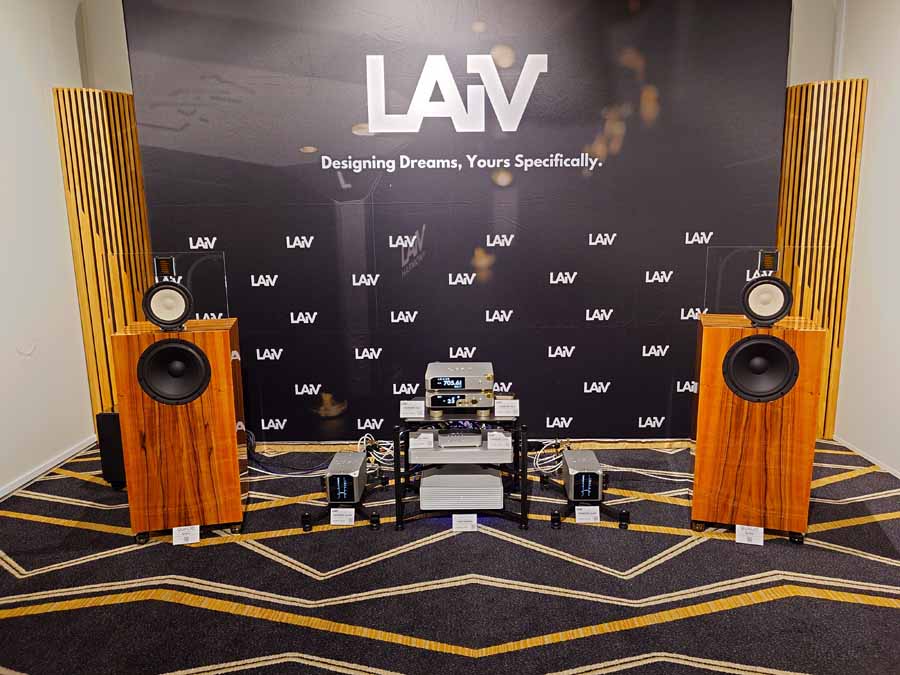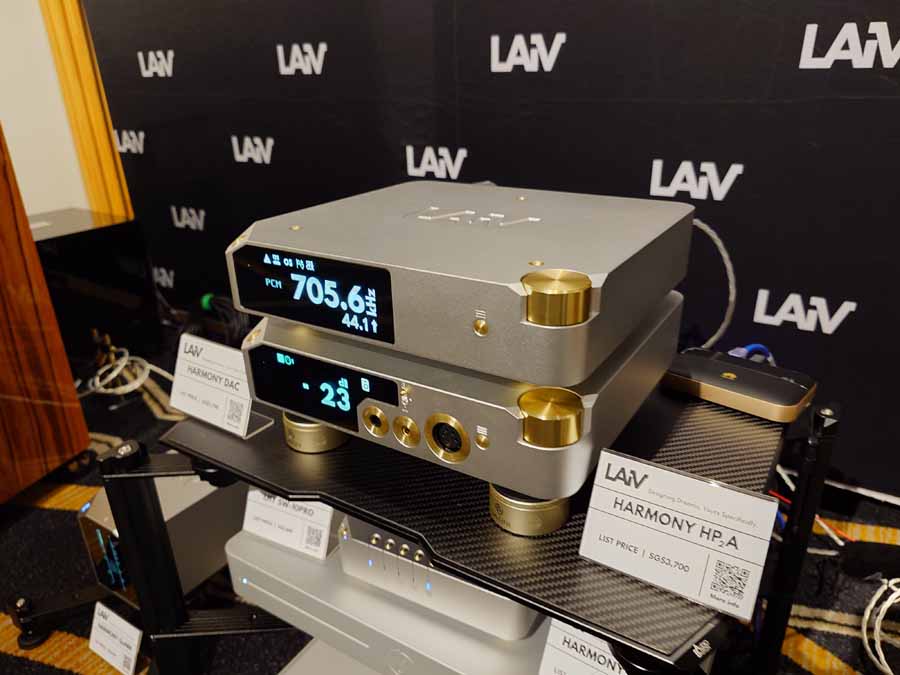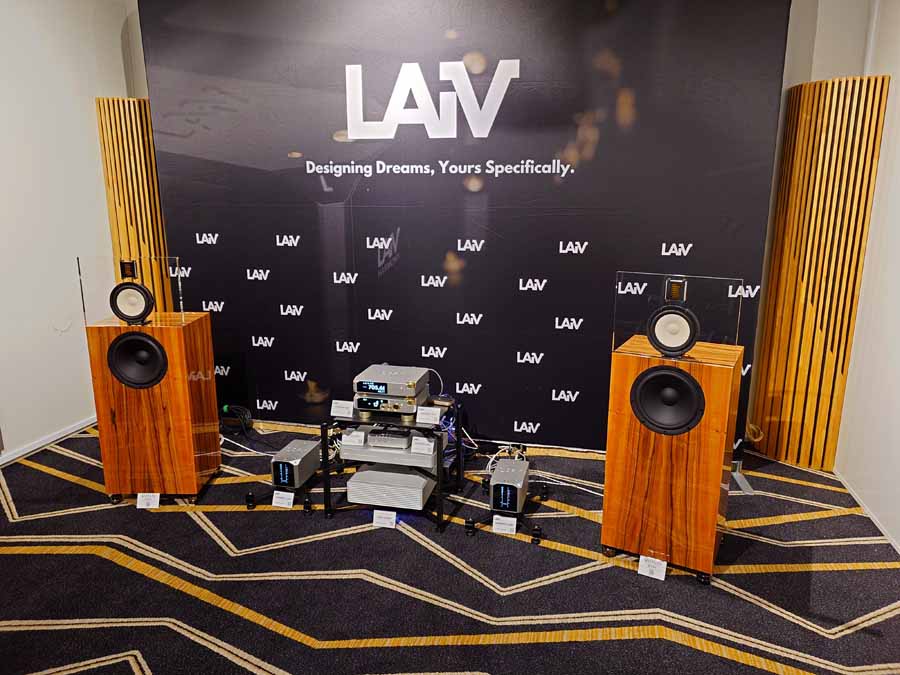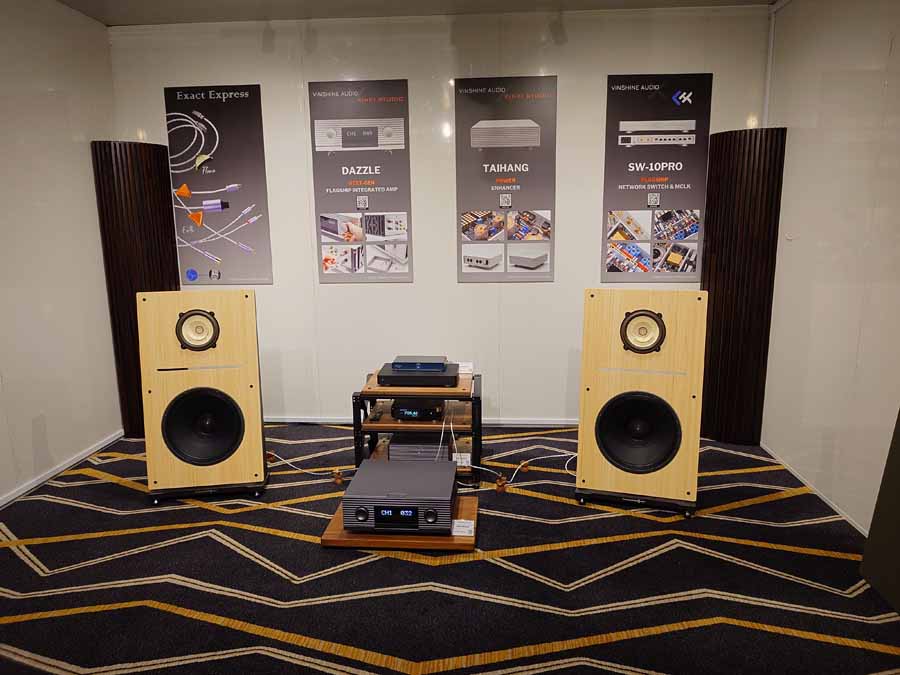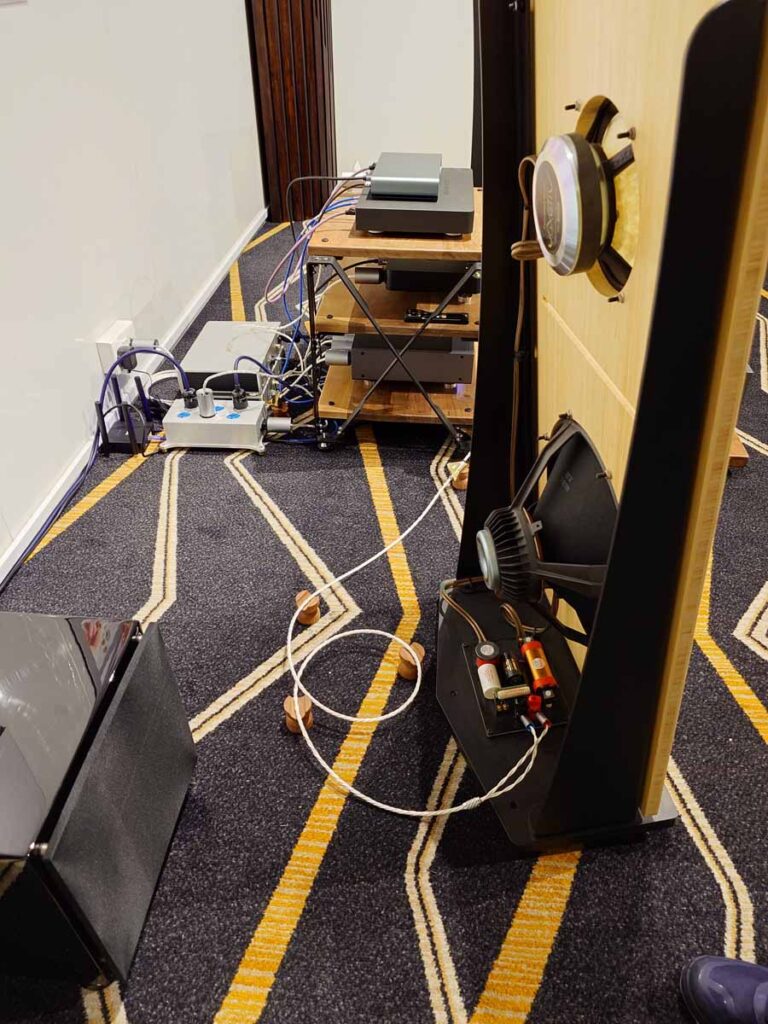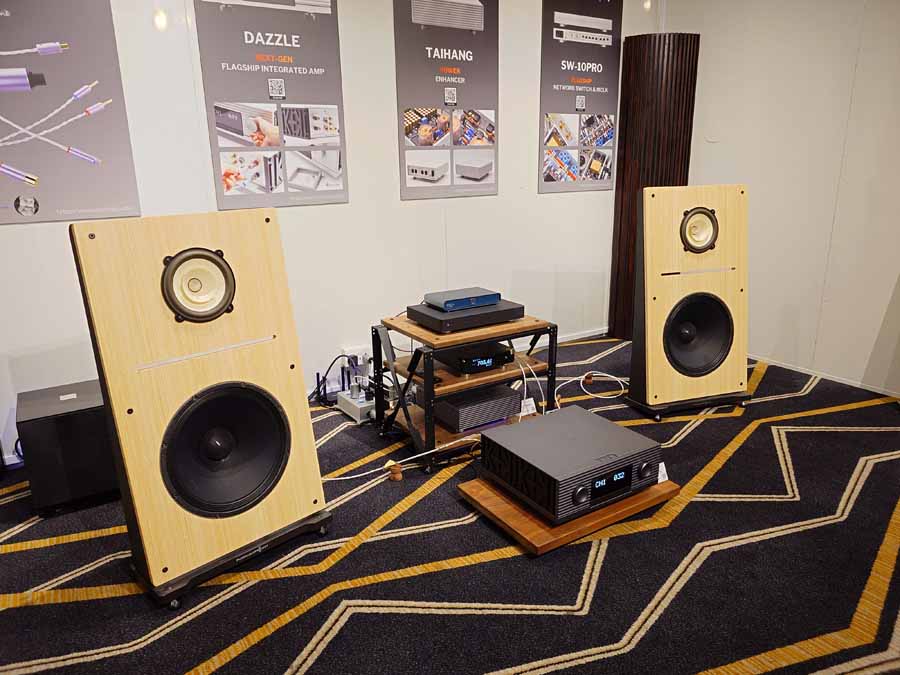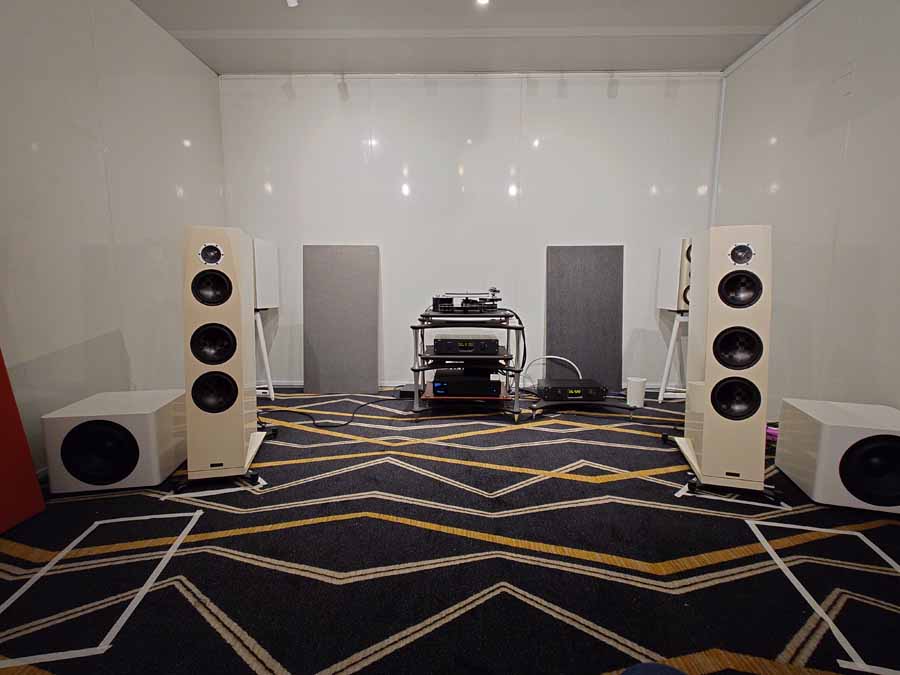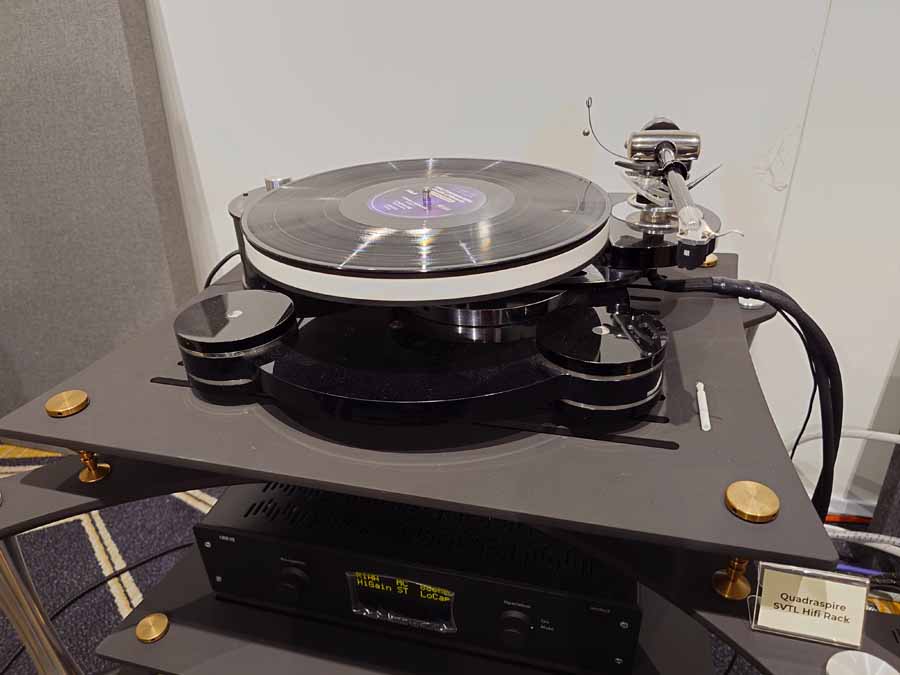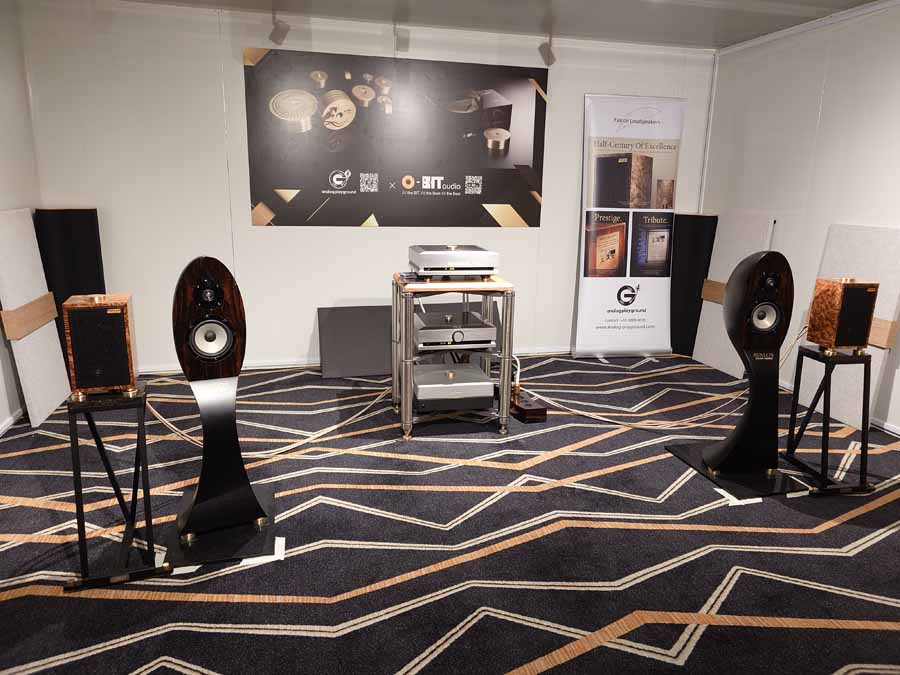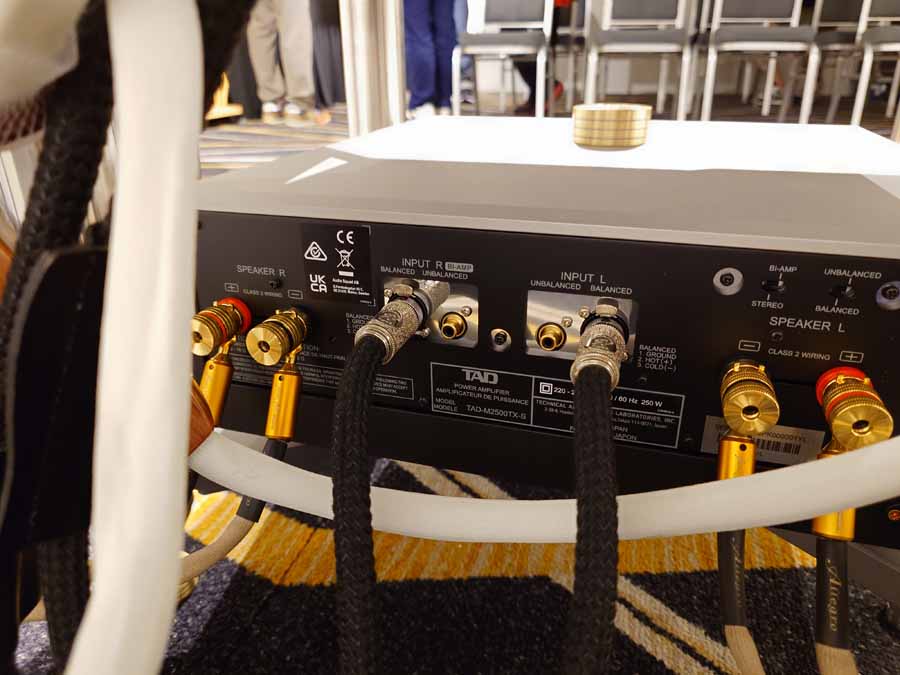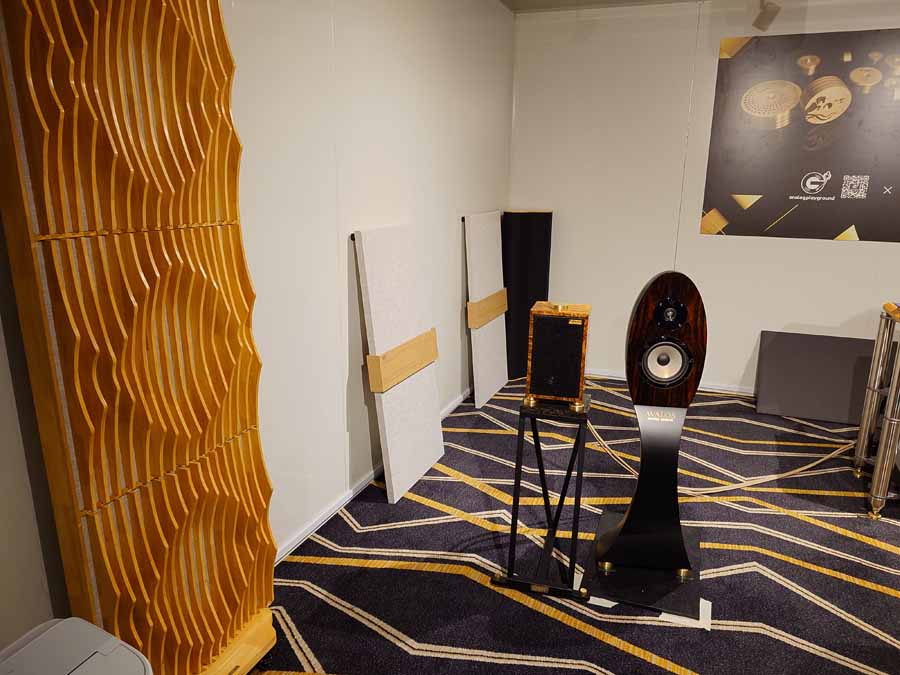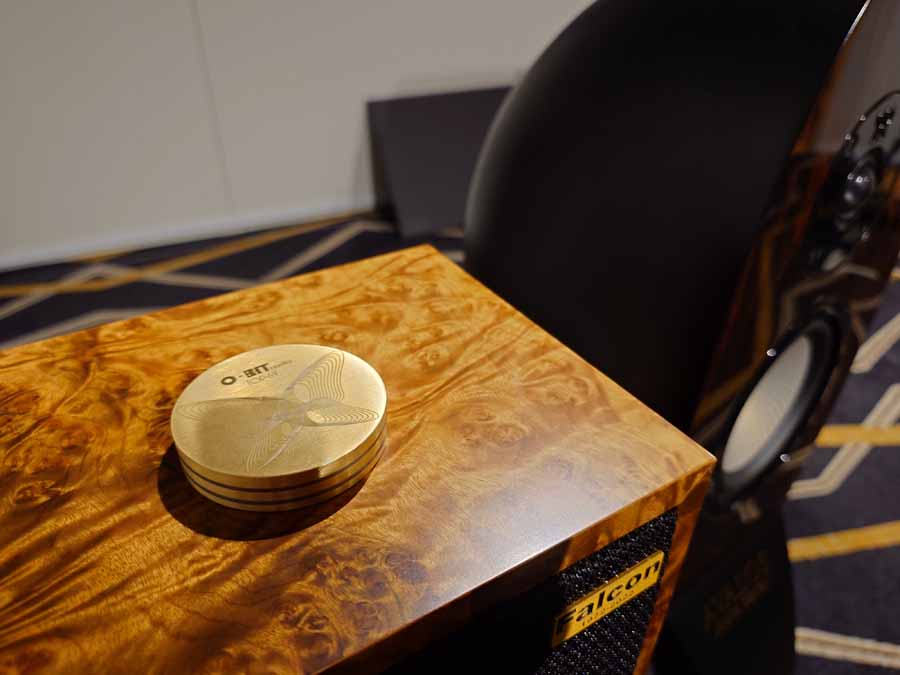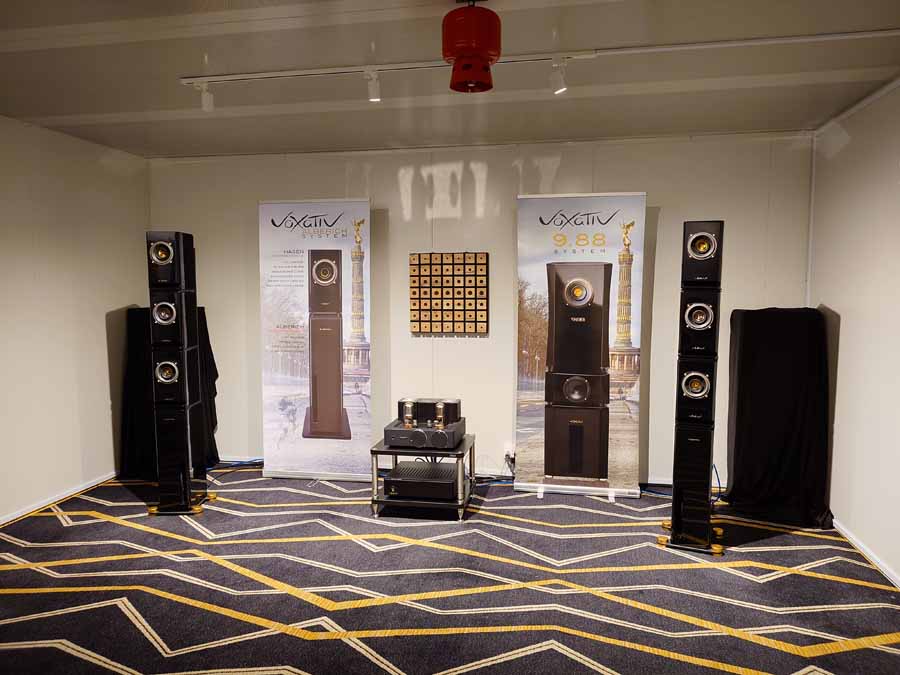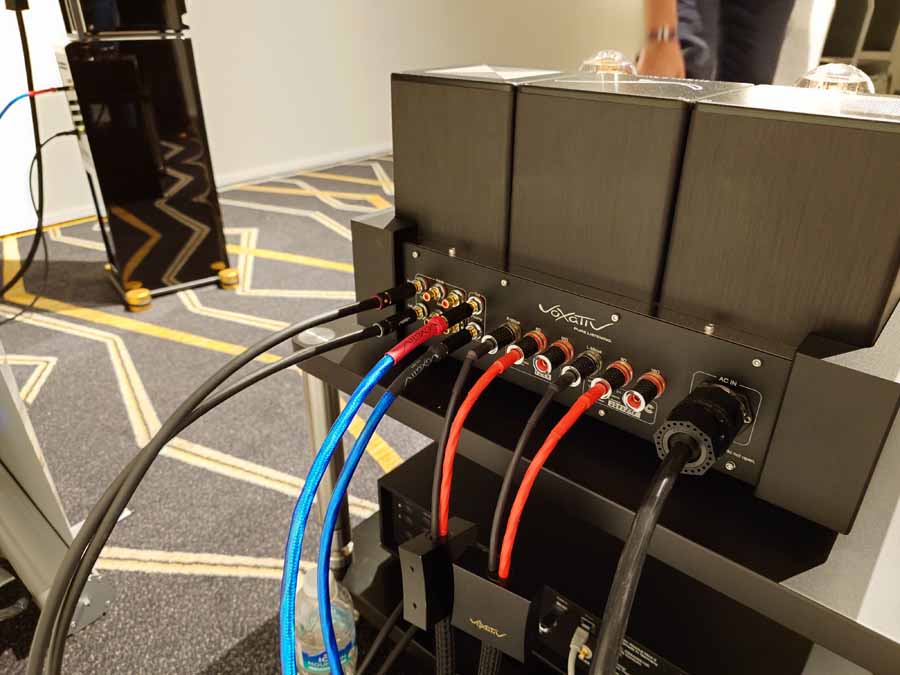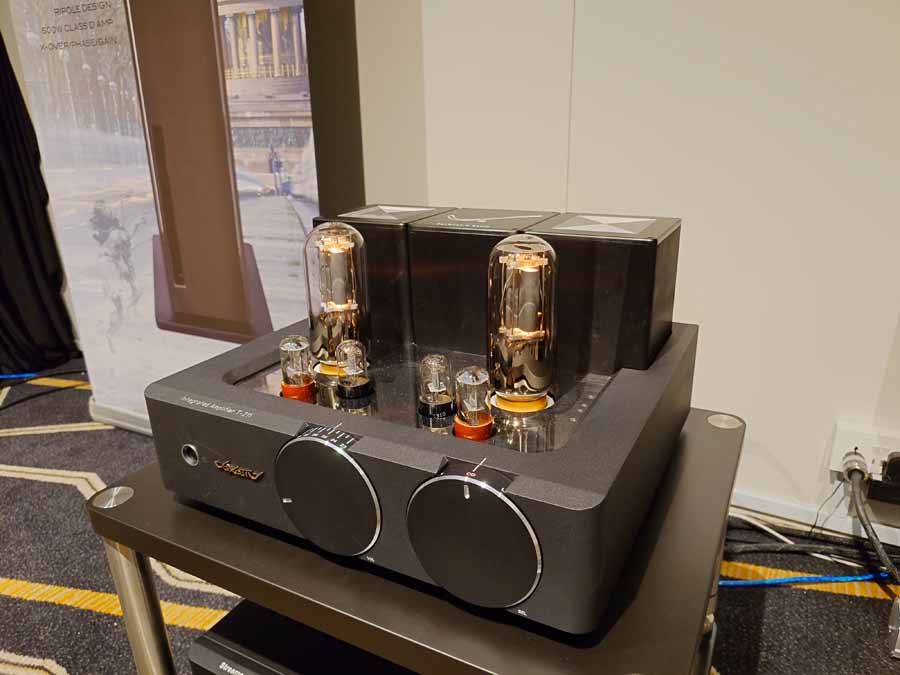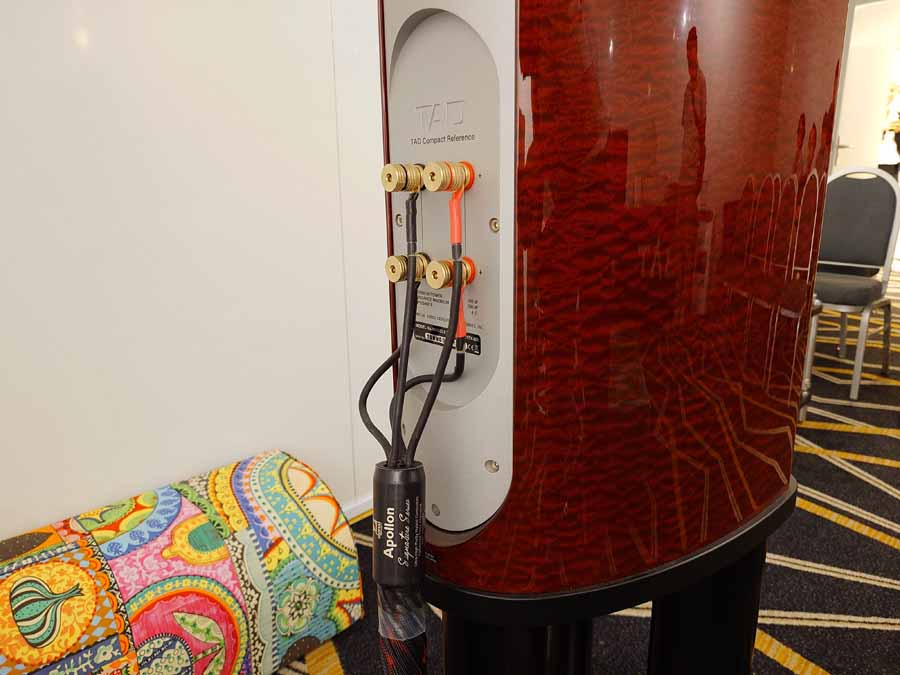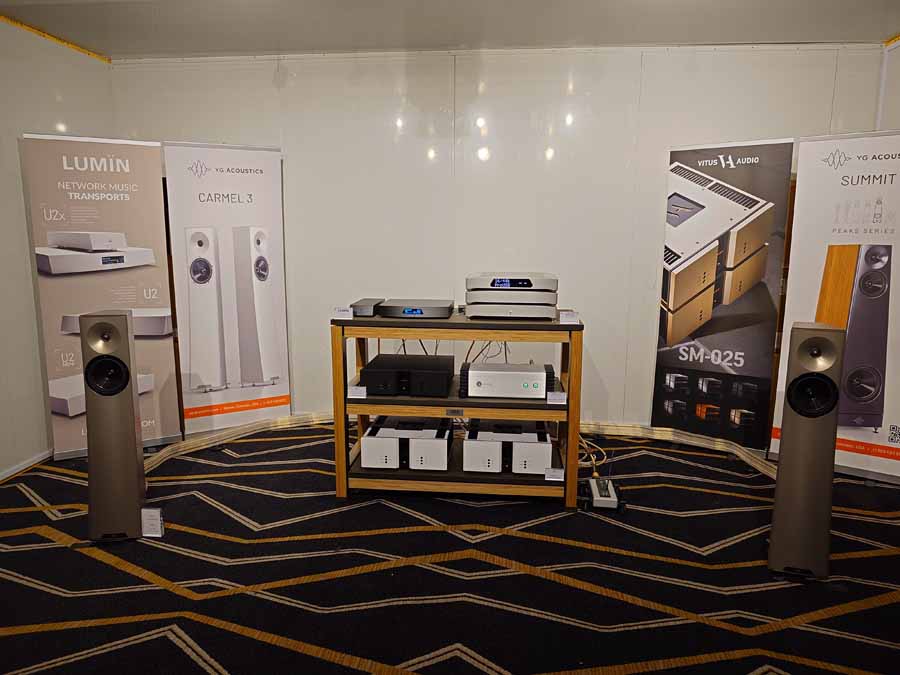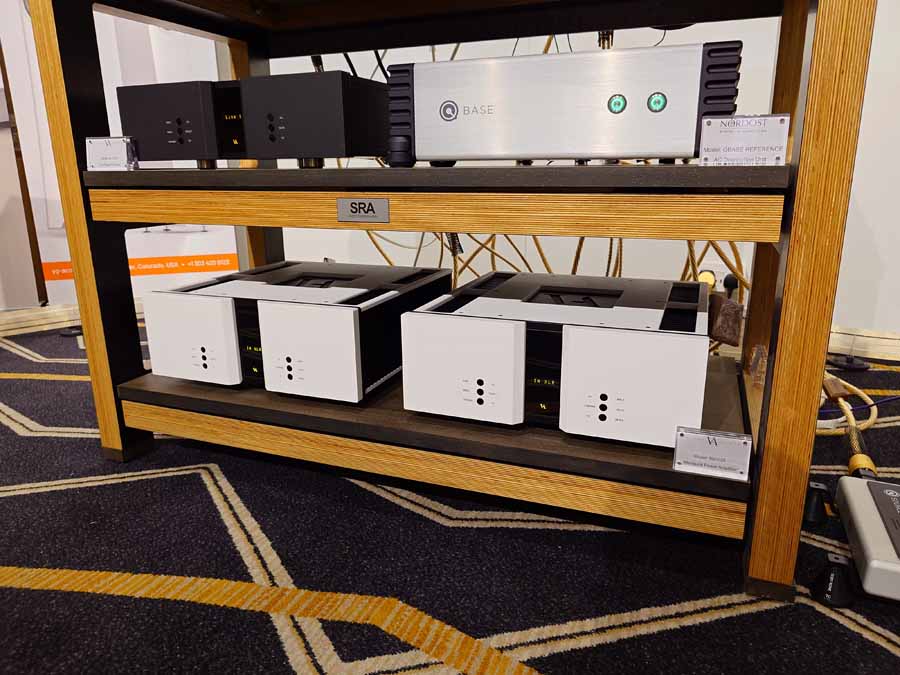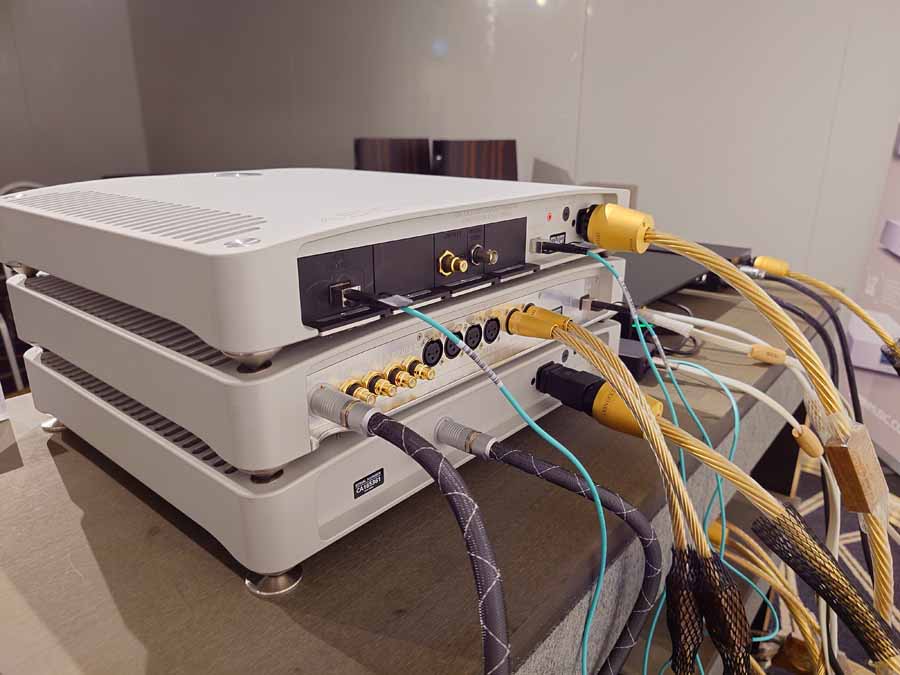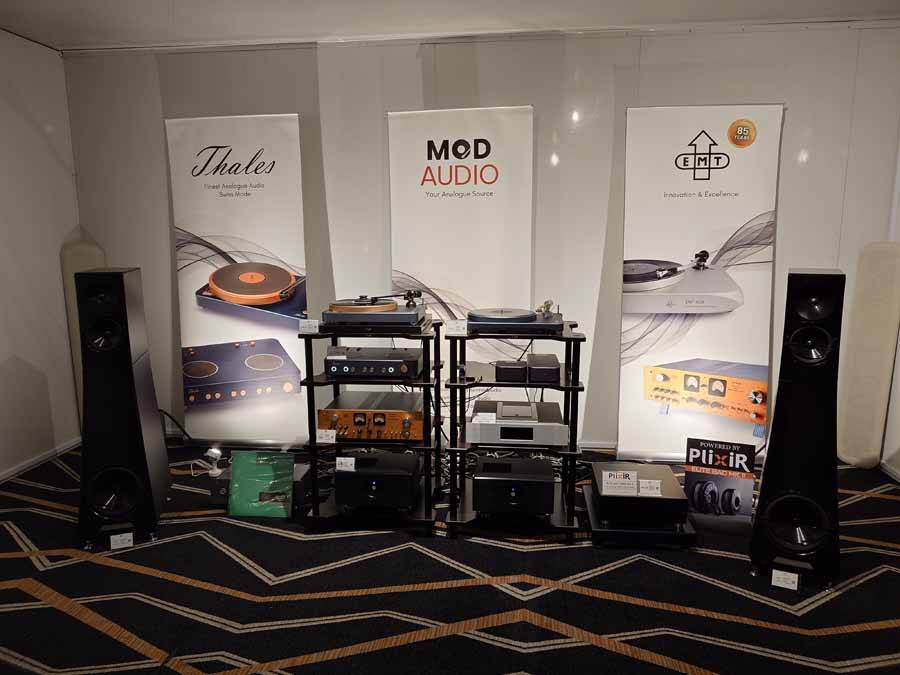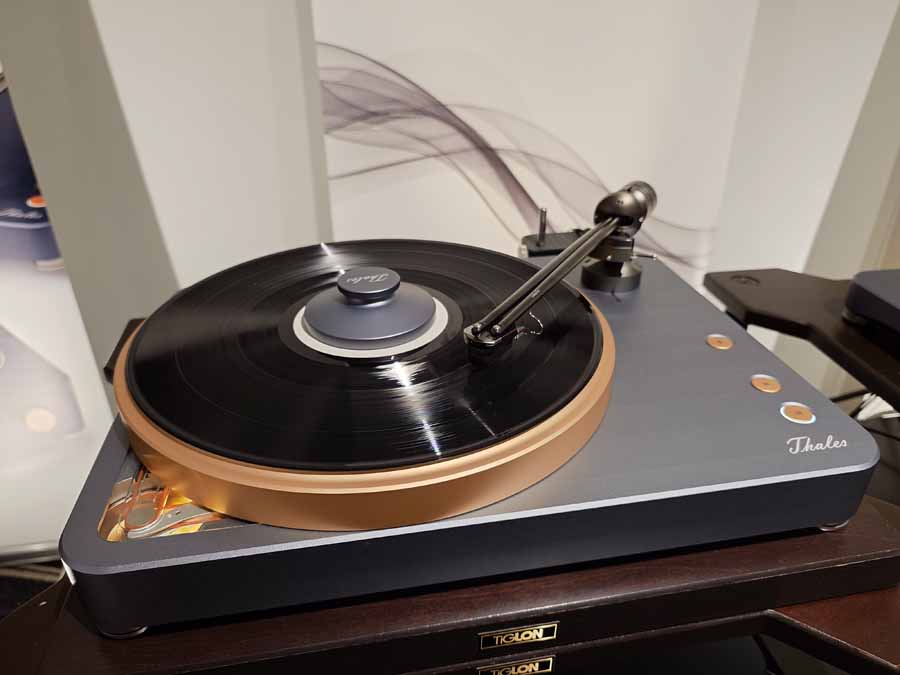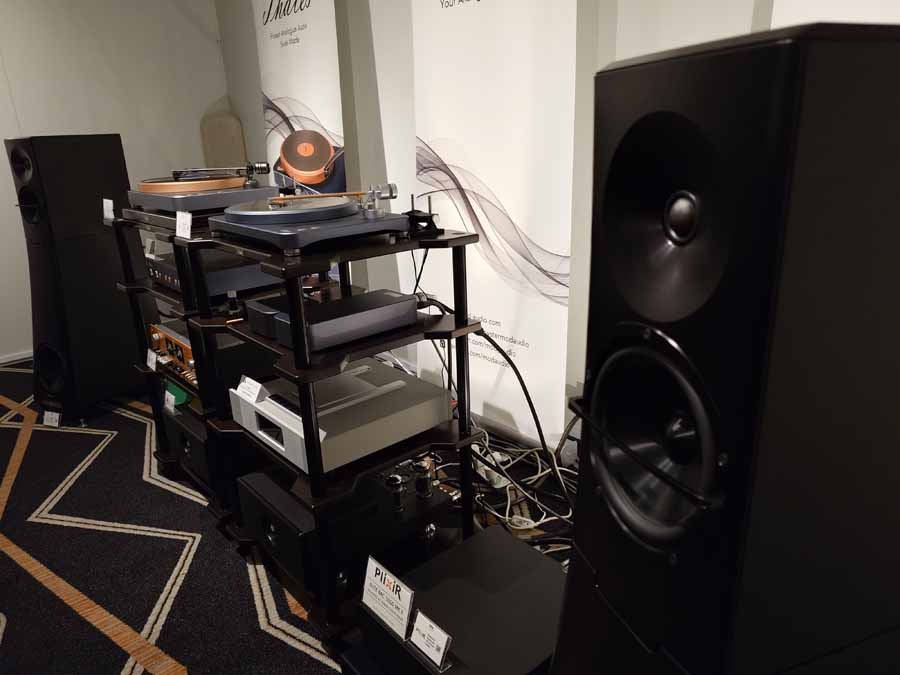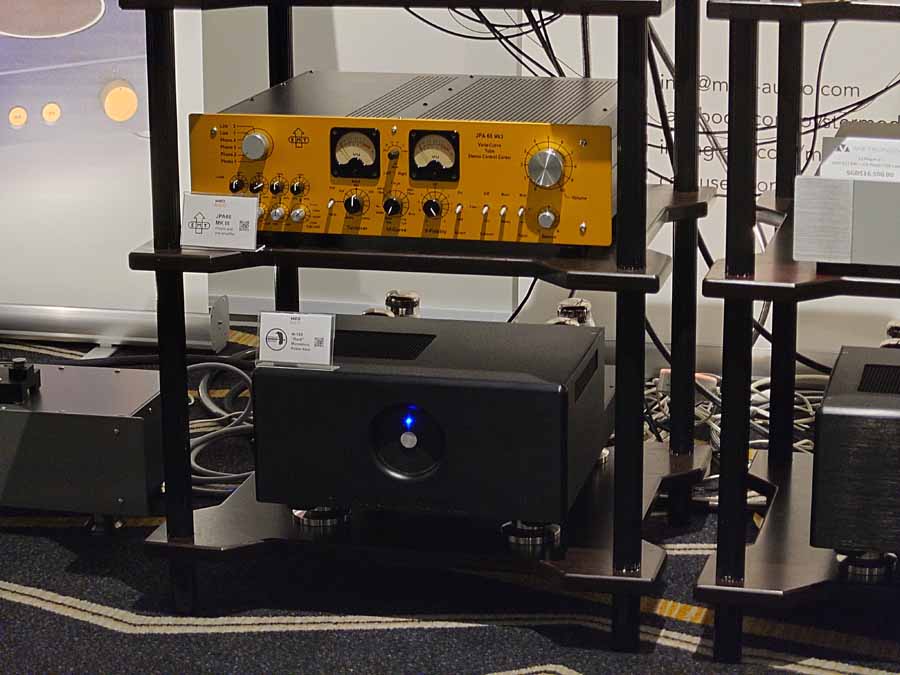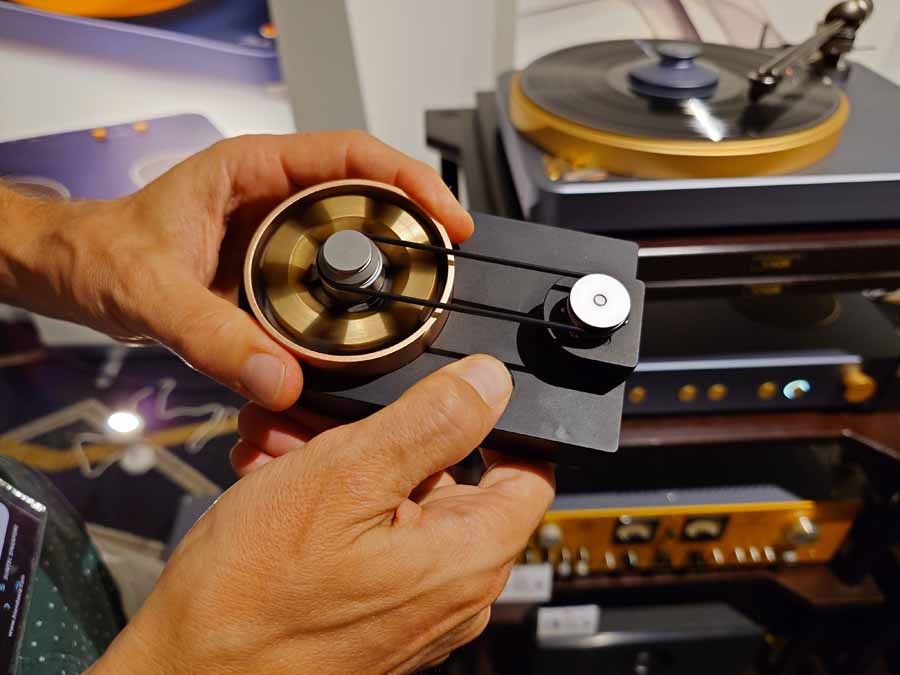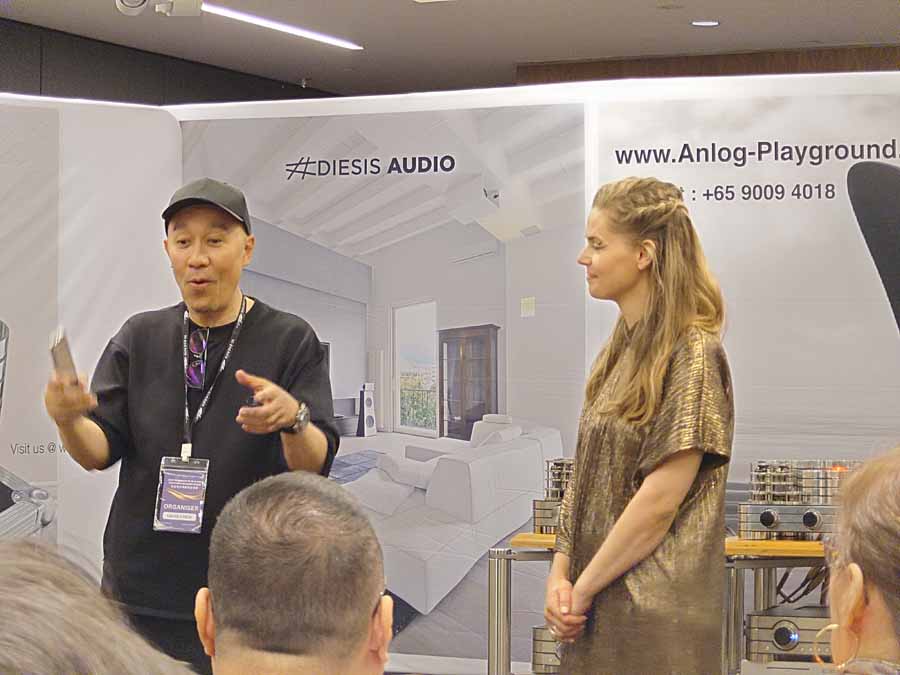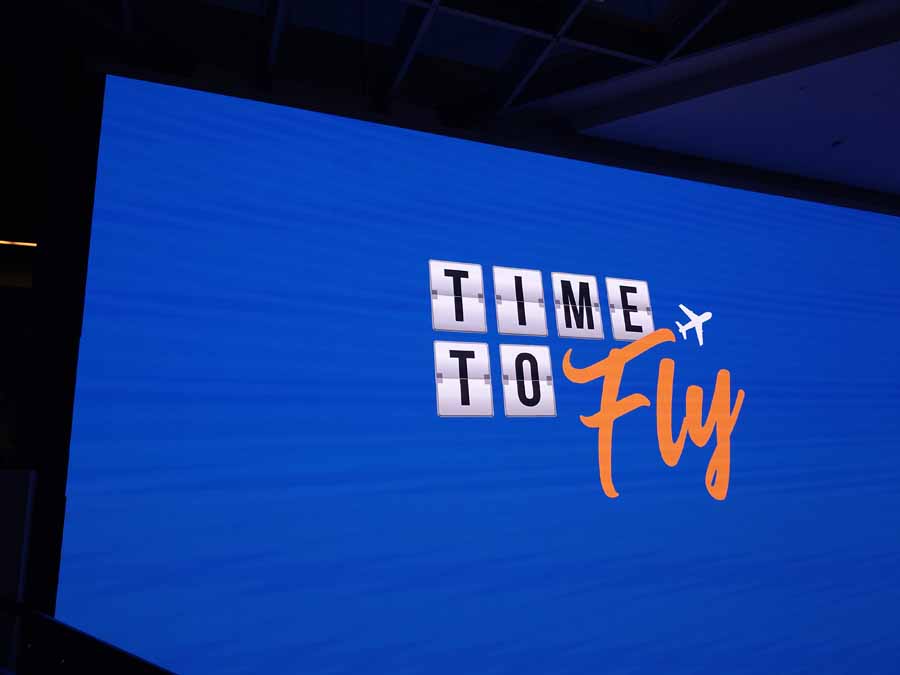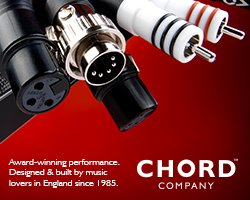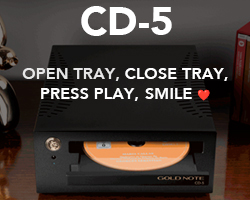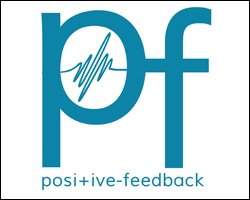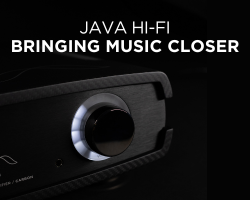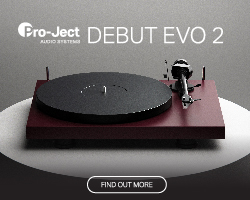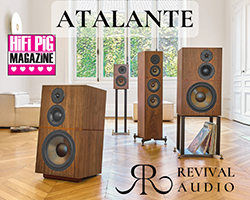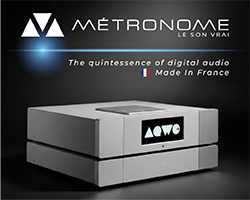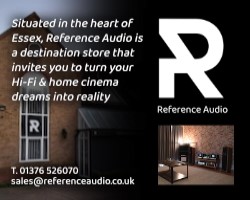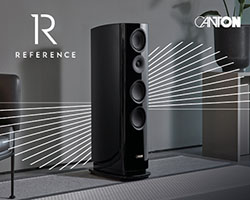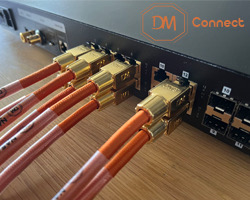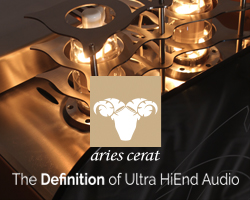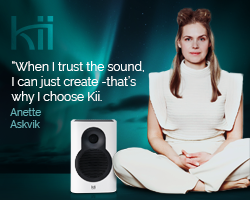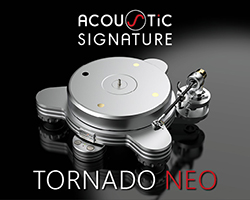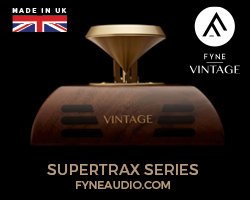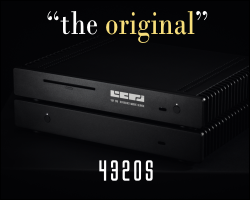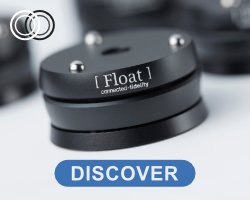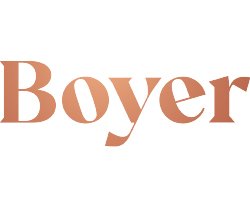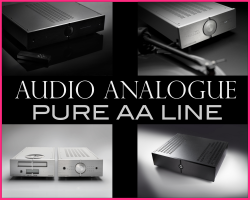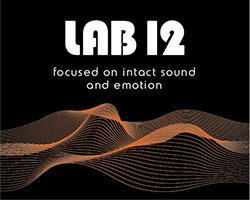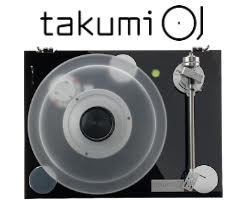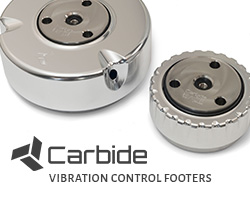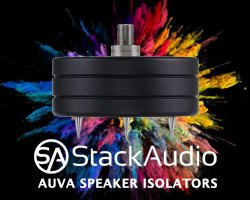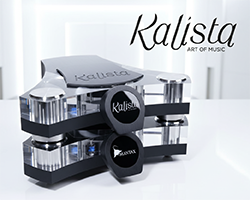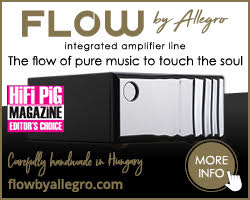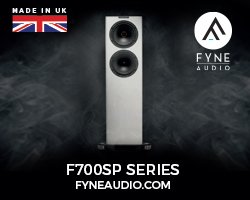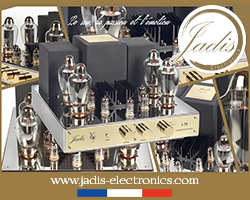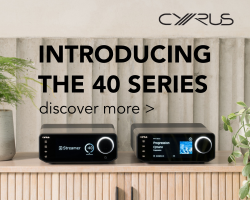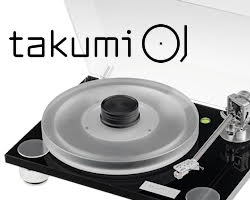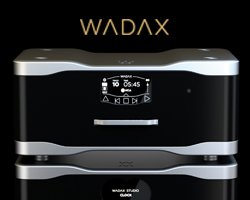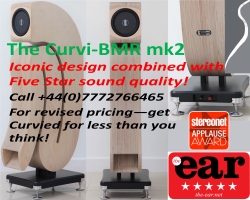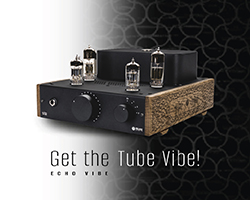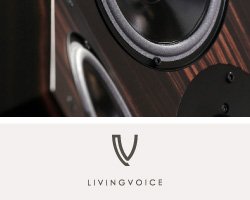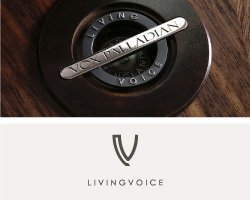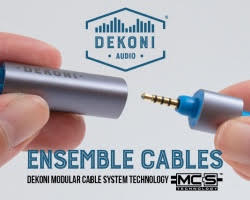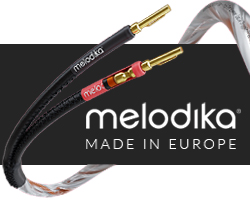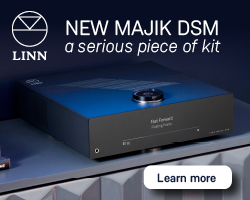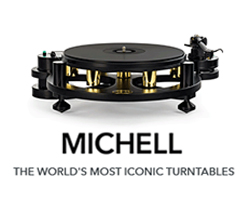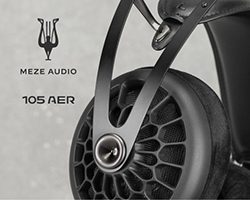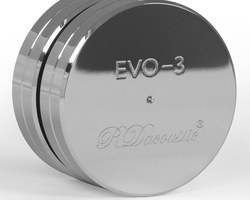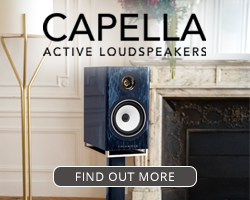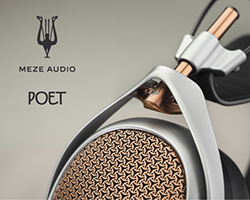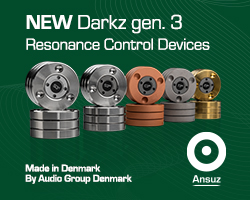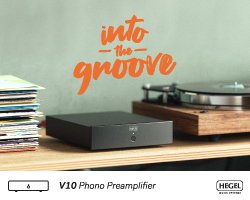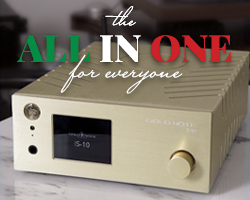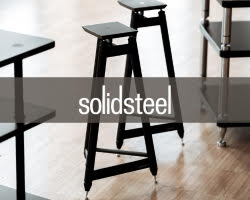GYULA BRINGS YOU THE SECOND PART OF HIS HI END ASIA SINGAPORE 2025 HiFi SHOW REPORT
We hope you enjoyed the first part of our Hi End Asia Singapore 2025 HiFi Show coverage, now join Gyula for Part Two.
HI END ASIA SINGAPORE 2025 REPORT PART TWO
Please note, all content and photos are the copyright of HiFi PiG Magazine/Big Pig Media LLP and must not be copied or reproduced in any way without the prior, written consent of the editor.
ROOM 335 AUDIO MAESTRO (AUDIOVECTOR, LUXMAN)
Audio Maestro’s second room followed the same philosophy as their previous showcase: presenting compelling options at different price points.
The Flagship (SGD 410k): The Audiovector R10 Arrete speakers were paired with the flagship line from Luxman: the D10x digital player, C10x preamplifier, and dual 10x monoblock power amplifiers, with the NT7 network transport rounding things out. The analogue side was built around the J. Sikora Aspire turntable—a Polish-made beauty fitted with DS Audio’s Grandmaster optical cartridge and equalizer. Ansuz optimization and Solid Steel stands completed the picture. What made this system tick was how three different audio cultures simply worked together—each bringing something to the table.
The Alternative (SGD 94k): The Audiovector R6 Arrete paired with the Aavik U188—a compact and elegant all-in-one solution.
What stood out to me was the Luxman Audiovector pairing, especially with the analogue playback. It was a rare kind of synergy: Japanese precision engineering from Luxman and DS-Audio, Estonian clarity and directness from Audiovector, and Polish craftsmanship from Sikora’s turntable design.
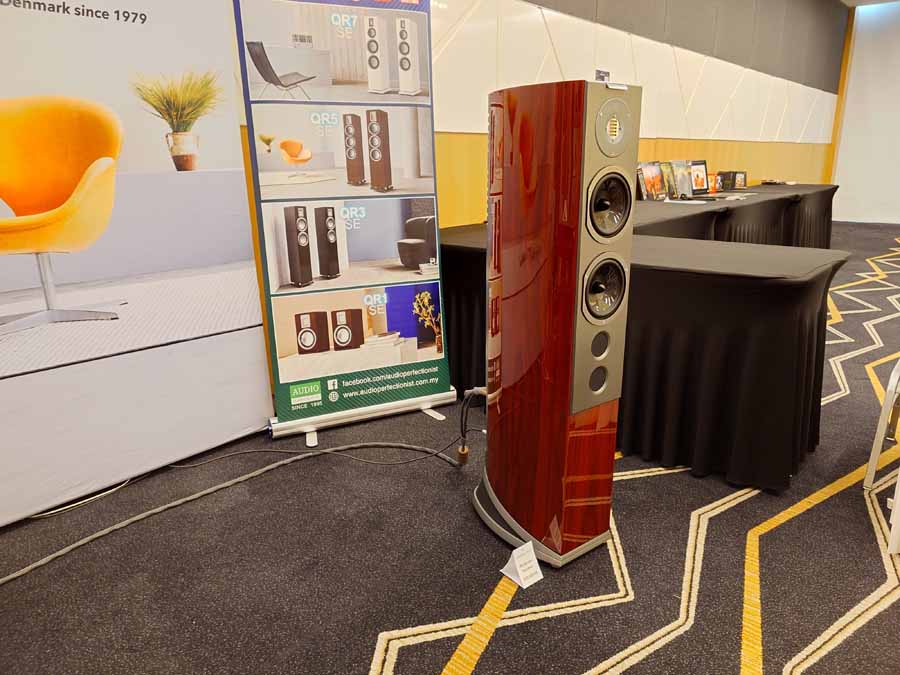
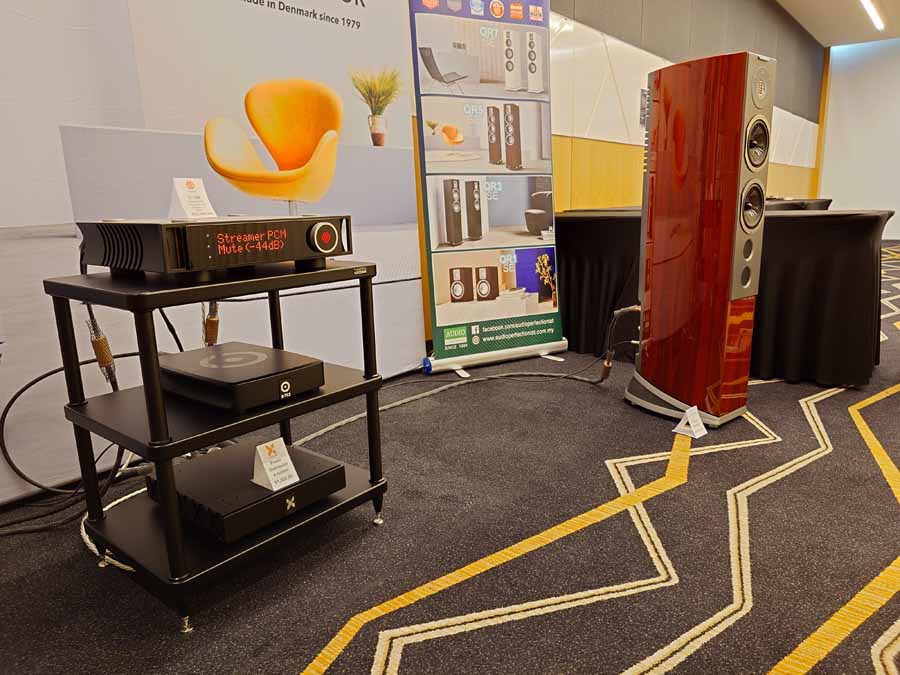

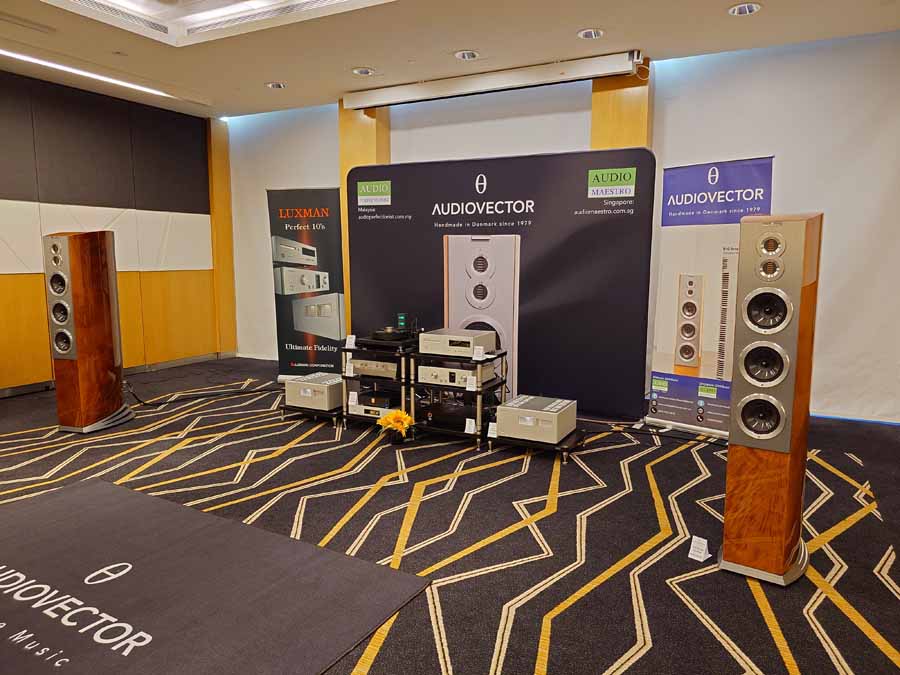


ROOM 334 (AVANTGARDE ACOUSTIC)
Avantgarde’s room presented their vision of a complete system: the Mezzo G3 paired with Airtight tube amplification and EMM Labs’ DV2i as the digital source, all conditioned through Shunyata’s power distribution and cabling. The combination of Japanese tube refinement with the Mezzo’s legendary horn efficiency created something immediate, compelling and cozy.
But the real intrigue sat in the corner: a speaker wrapped in white cloth, deliberately veiled from view. It’s Avantgarde’s upcoming release, still under wraps but making the rounds to build anticipation. I grabbed Jerome for a proper conversation about what’s coming, and while NDA keeps my lips sealed on specifics, I can tell you this much—it’s positioned to shake things up.
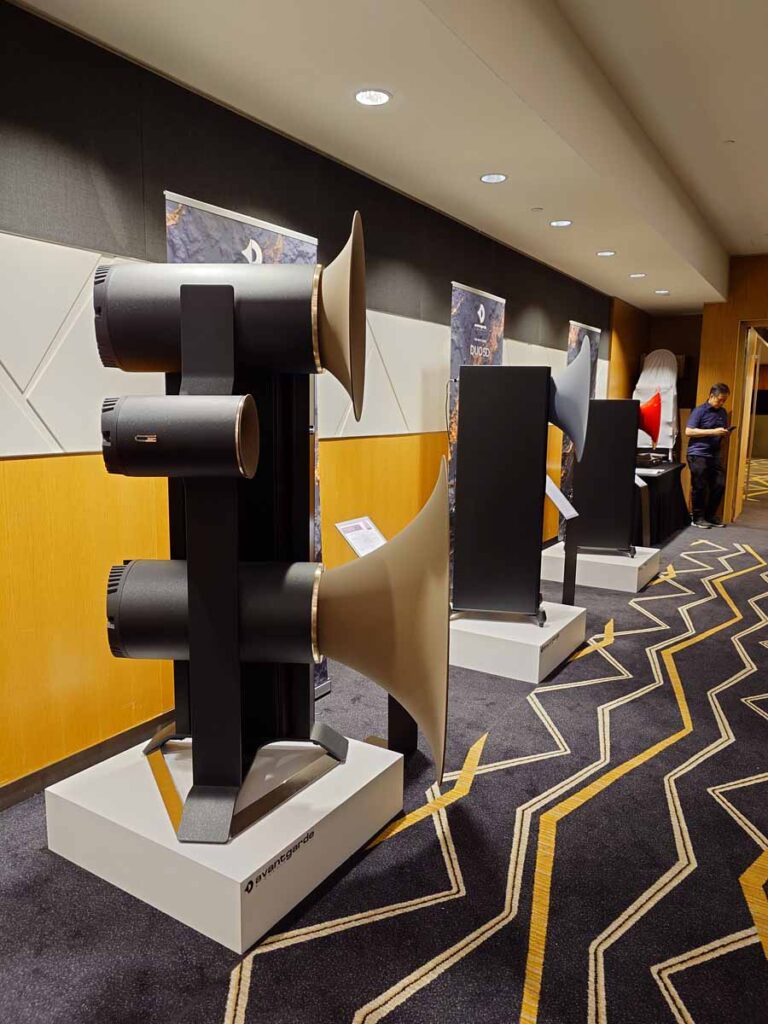
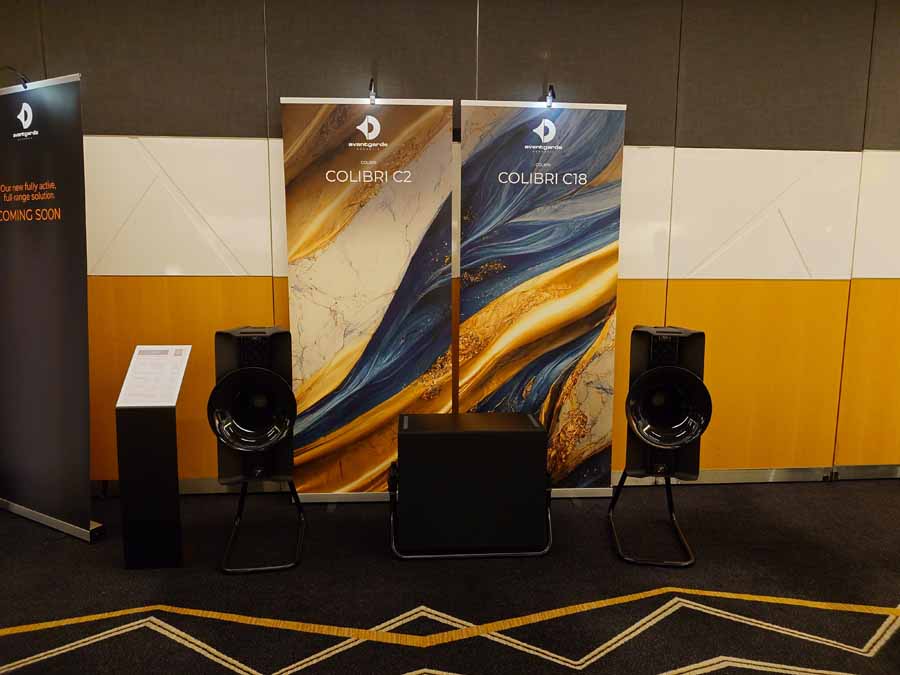

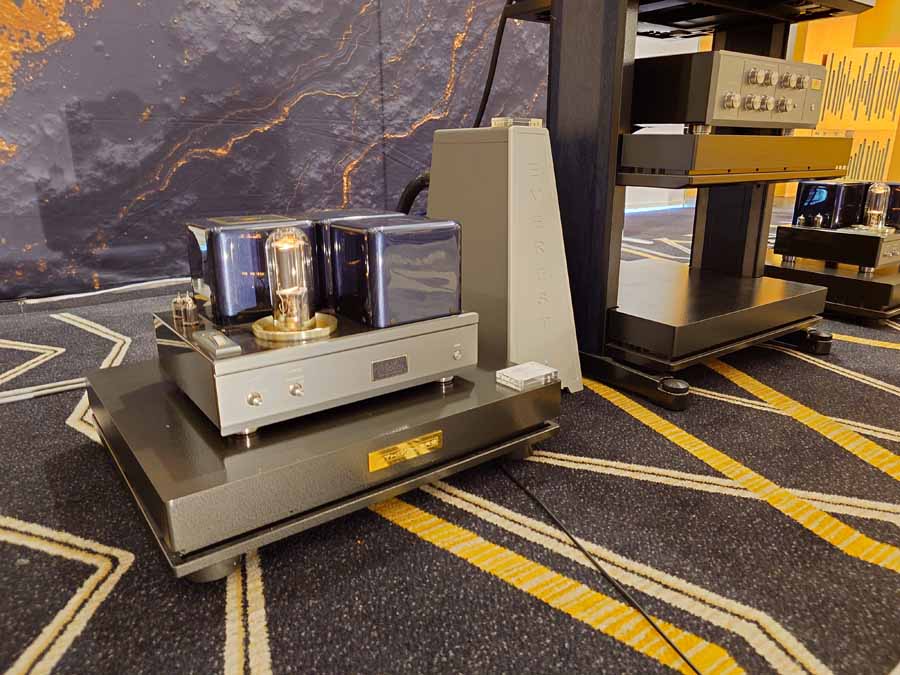

ROOM 333 AUDIO EXOTICS (VERTERE, ENGSTROM, RIVIERE, APL, FALKANOHR, JMF, CESSARO, GOEBEL)
Audio Exotics delivered precisely what their name suggests: an international showcase of exotic brands, even bringing listening sessions hosted by turntable legend Touraj Moghaddam. Photography was nearly impossible, thanks to the striking deep orange divider that split the space in half, creating room for two distinct sonic philosophies.
System One was right at the entrance. The Vertere DGx turntable with a Mystic II MC cartridge (Moghaddam’s own creation) was fed into the Vertere Phono 1 Mk2, setting the analogue foundation. The digital side came from Bulgaria via APL’s Pure DSD GR reference DAC—complete with Class-A tube output stage for that rare blend of technical precision and musical warmth—paired with the NSP-GR server and streamer. Riviera Labs’ APL-1 preamplifier bridged both worlds, while Scandinavian muscle arrived courtesy of Engström’s Lars monoblock amplifiers. These drove the Cessaro Wagner I horn speakers, augmented by Arya Blade wide-dispersion tweeters and Opus subwoofers for full-range authority.
System Two shifted the analogue narrative entirely. The Vertere SG-1 with the Super Groove II Pathfinder tonearm and Ruby One cartridge fed into the Calon phono equalizer. Digital playback came from Synästec Audio’s Origo II SACD player and Pink Faun’s 2.16 Ultra. French refinement entered through the JMF PRS 1.5 preamplifier and HQS6002 power amplifier, driving Goebel Marques speakers with Sovereign subwoofers. Esprit and Vertere cables tied everything together.




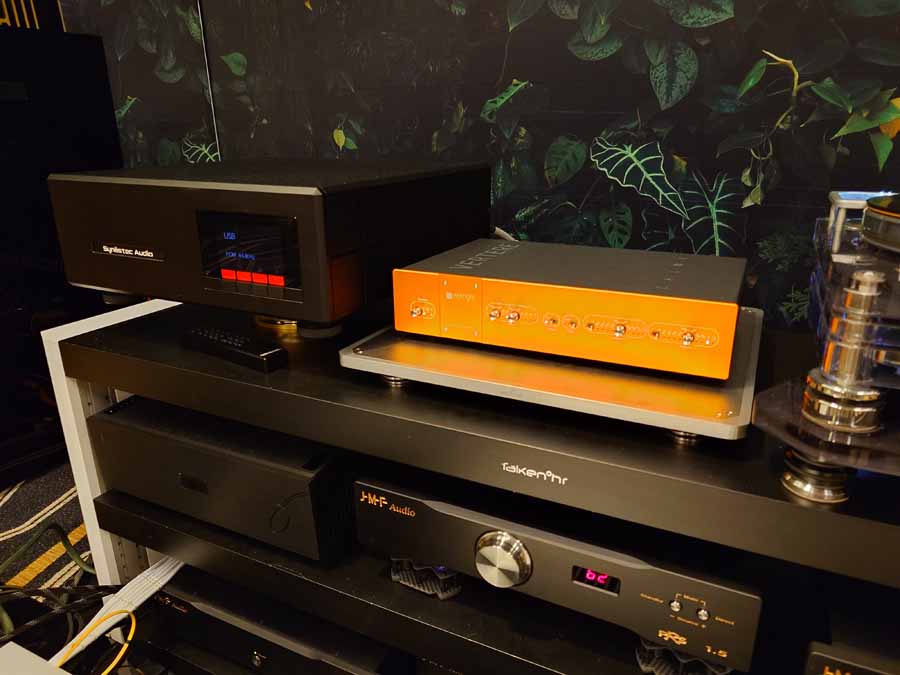


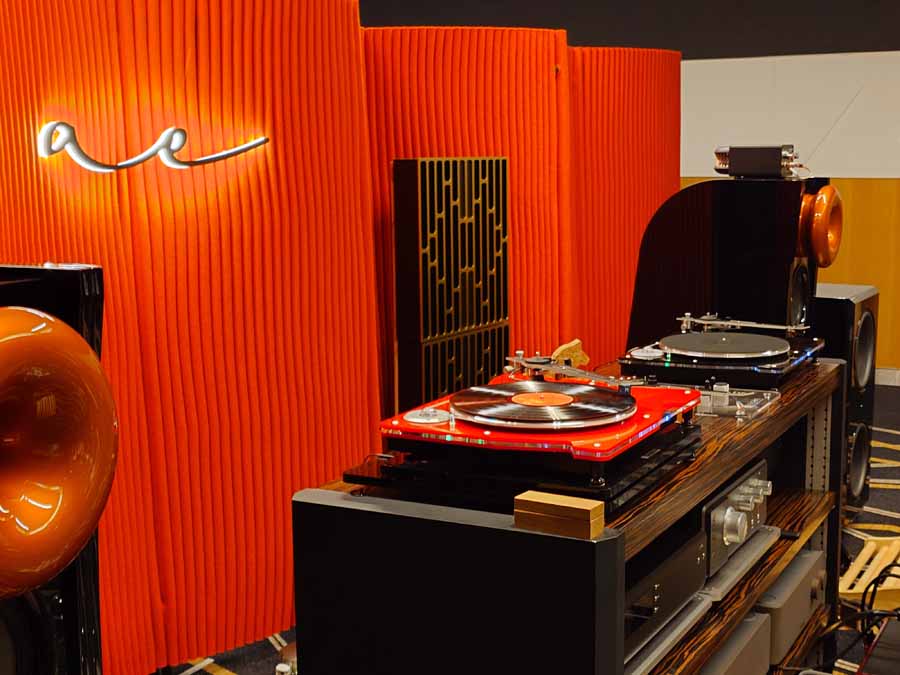
ROOM 332 SHARKWIRE, LINGKE, AUDIOONE
Lingke and AudioOne are new names on the global stage, and frankly, most of us step in without knowing what to expect. Upon entering the huge room, the minimalist setup almost felt out of place—standing tall in a refined hourglass shape, the Lingke Perception 211 speaker commanded presence. Next to it sat just two compact boxes with “AudioOne” written on the front. No knobs. No displays. No visual fanfare whatsoever.
Then you look closer, and you listen.
The Perception 211 reveals itself as a monster of an active speaker: 1800W of internal amplification, DSP-optimized tuning, and six drivers per side (beryllium tweeters, dual midranges, dual woofers, and dual subwoofers). The sound is authoritative, clean, and inviting—no compromises hiding in passive speaker boxes.
The AudioOne Symphony No. 7 matches that uncompromising spirit: a reference-level network source delivering native DSD1024 support, a >110dB signal-to-noise ratio, and architecture with separate left and right channel power supplies for ultimate channel isolation. Sharkwire’s Great White Shark flagship cables tied everything together—premium metallurgy that completed the conversation rather than merely connecting boxes.
In a smaller room, they demonstrated an active bookshelf, the LK-T5, which has dual power amplification on both sides, wireless connectivity, and APTx. They sounded larger than their size, with excellent accuracy and clarity.



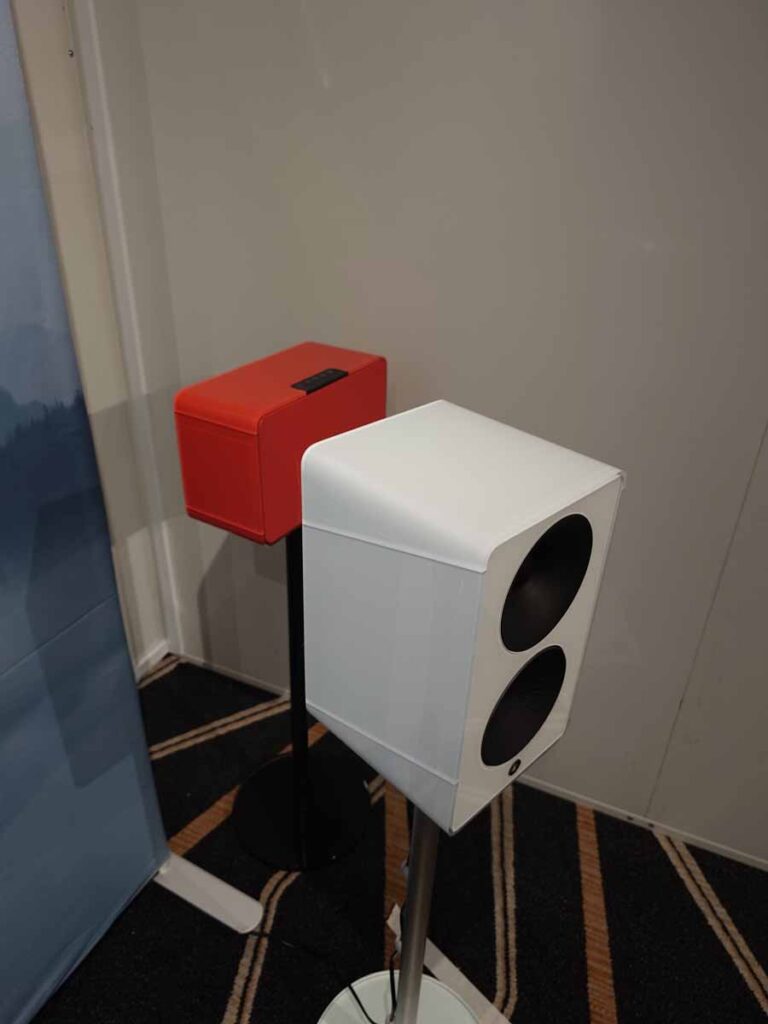
ROOM A2 HIFI.COM.SG (AUDIONOTE)
Audio Note’s philosophy was always elegantly simple: when a manufacturer controls every component in the chain—from power supply to turntable to amplifier to speaker—the result is coherence. In the small, undecorated room that is what they represented. Simple, straightforward setup. The TT Three turntable with its dedicated PSU features three equilaterally-positioned motors driving a lightweight Lexan platter, AN tonearm and IO I cartridge. The Meishu integrated amplifier and AN-J/Se loudspeakers complete the ecosystem, with the CD 5.1x handling digital duties. The setup had a Shunyata Denali power distributor and an Eversolo network streamer for an additional source.
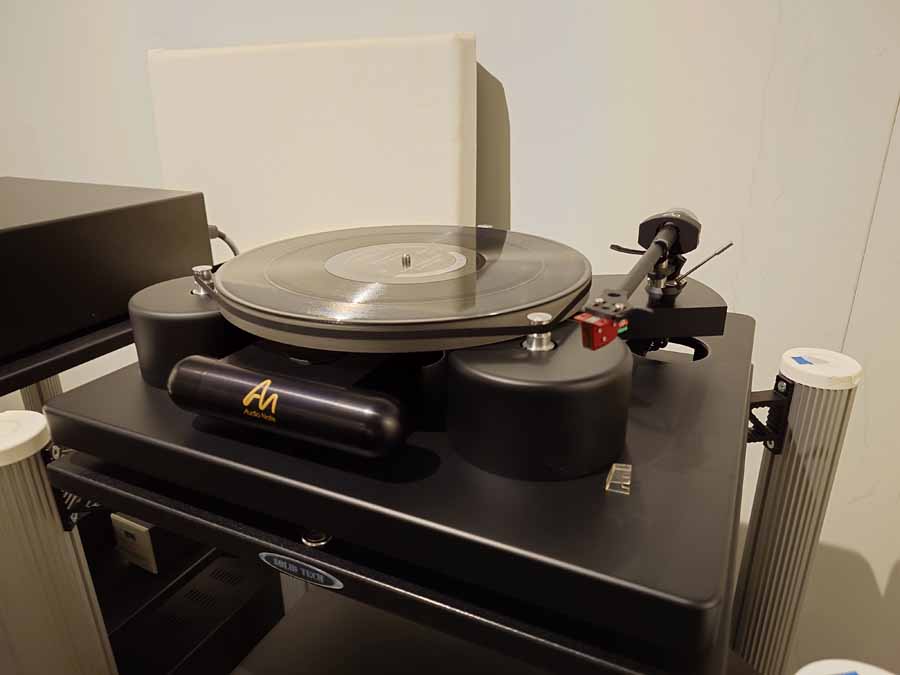

ROOM A4 SG LIVE ACOUSTICS / POINT
Point, a Taiwanese DAC and power supply specialist, built their demonstration around a clear methodology: direct A/B comparisons. The main setup paired ATC SCM20 and Eposound speakers with the Line Magnetic LM-805 integrated Class-A SET amplifier—an uncommon sight, as integrated 805-tube designs are rare.
Audio sources included the AudioDesign SW1X DAC (TDA1541-based with valve output) and Line Magnetic LM515 MKII tube CD player. The focal point was the Power Master 20A digital power filtering processor, demonstrated through side-by-side A/B listening sessions that allowed immediate comparison of its impact. Point also showcased the Propre 2000 Streaming DAC as an alternative digital option.
It’s always a good idea to demonstrate the impact of less conventional equipment in a comparative listening session, and this room did it admirably.

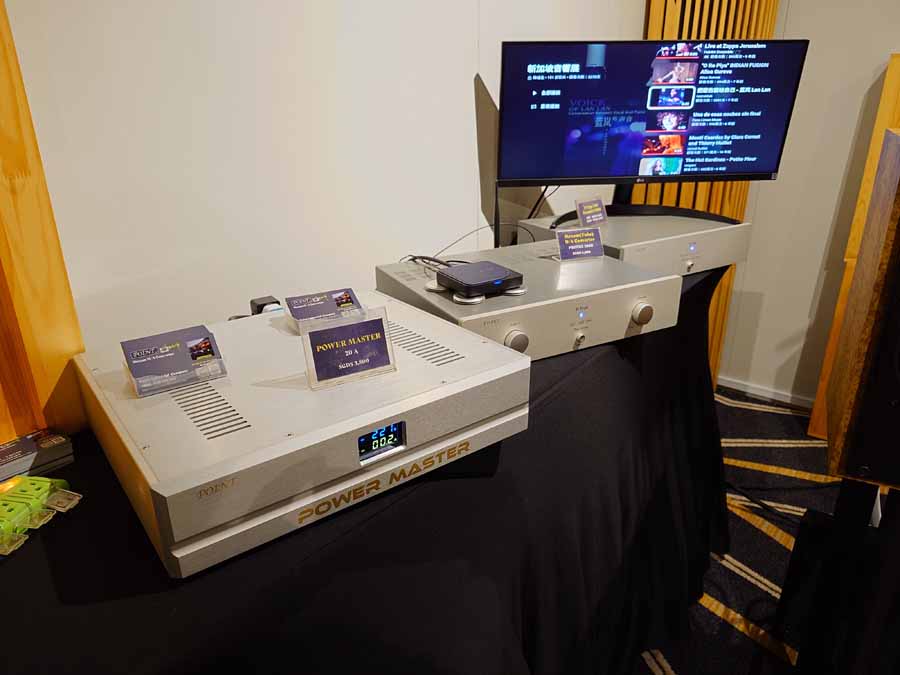
ROOM A5 LAIV
LAIV Audio, a proudly Singaporean and relatively young brand, has already gained international traction thanks to their thoughtfully designed product line. Having been impressed by their setup at previous shows, I was eager to hear what they’d deliver on home turf.
The speaker of choice this time was one of HiFi PiG’s favourites, the pick of 2023, the Qualio IQ Ultra. The complete Harmony line was on full display: the GaNM monoblock amplifiers, the Harmony DAC with its R-2R ladder architecture, with the µDDC digital-to-digital converter and reclocker, and the HP.A (combined preamplifier and headphone amplifier). Supporting cast came from local distributor Vinshine Audio—the LHY SW-10 Pro network switch and Kinki Studio EX-B7 power enhancer—further refining what was already a well-considered system. It was a great room to be in.
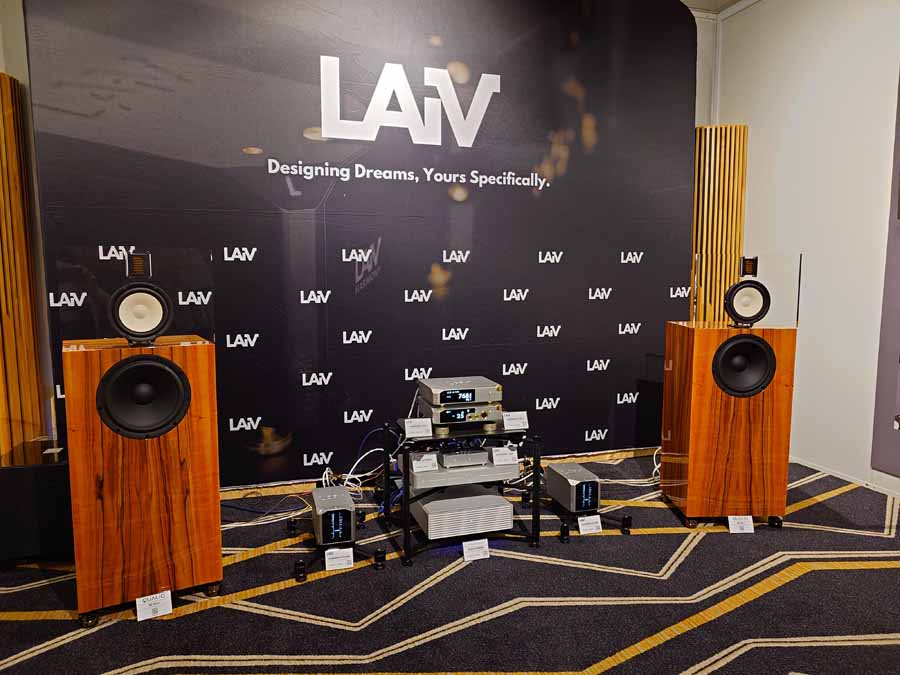
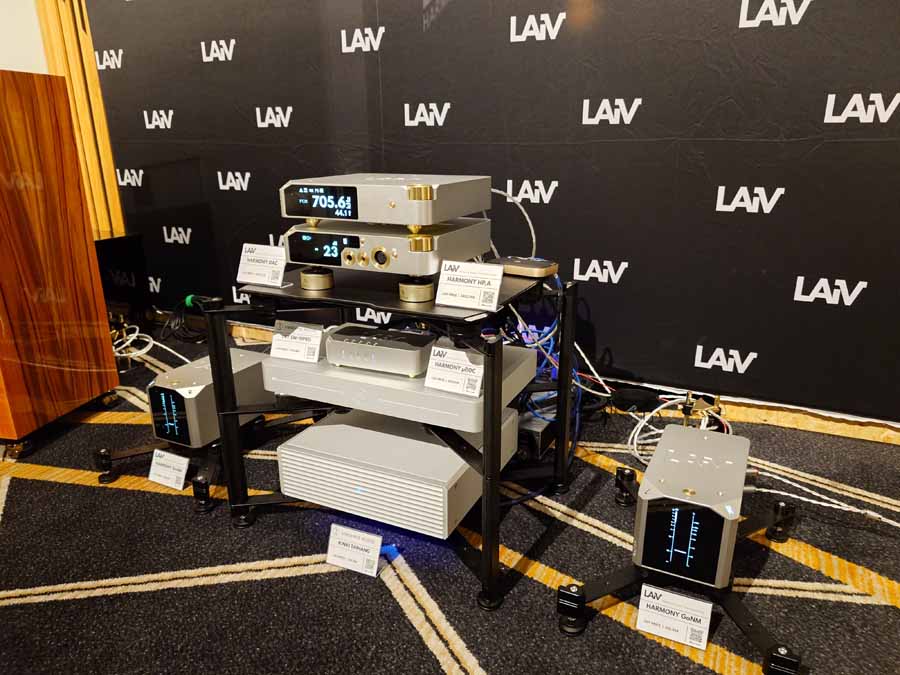

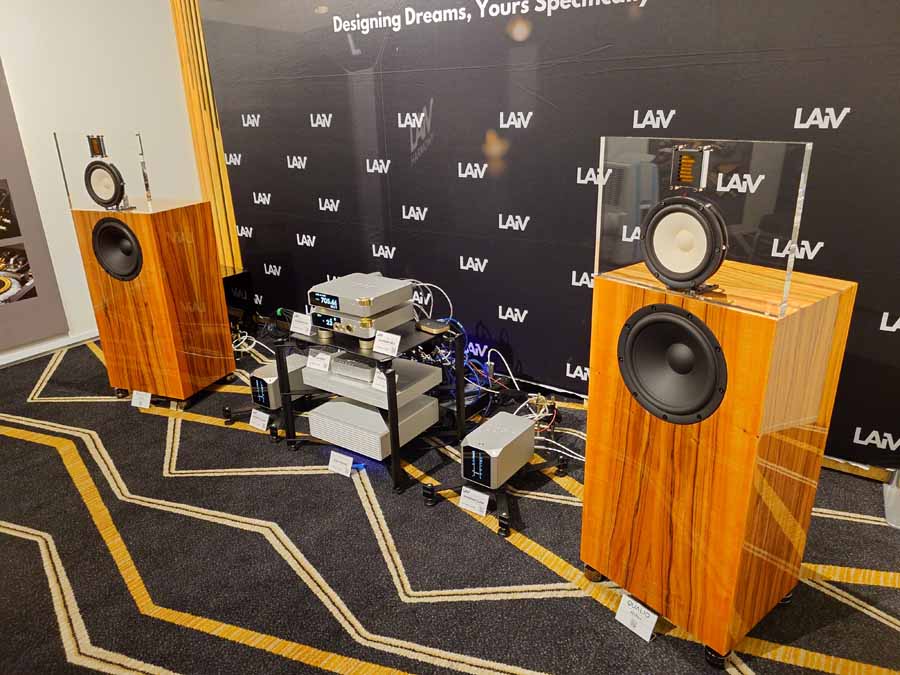
ROOM A10 VINSHINE, KINKI AUDIO
Vinshine Audio needs little introduction. As the distributor who made Denafrips a household name in the R-2R DAC world—one of the first DACs that “went viral”—they’ve certainly built credibility as tastemakers willing to champion unconventional, high-quality products. Their room exemplified this philosophy perfectly: a deliberately scaled-back setup built entirely from up-and-coming brands and affordable solutions that proved high-end audio doesn’t always require deep pockets. Like the microbrands Stu talked about in his most recent Sunday column.
The speaker came from Pure Audio Project—a semi-DIY solution that lets enthusiasts enjoy the building experience. Amplification arrived courtesy of Kinki Studio’s Dazzle integrated amplifier, a cooperation between the distributor and the brand that delivered surprising sophistication. The Volumio Revo+ networked music player paired with the LAIV Harmony DAC handled playback, supported by the LHY SW-10 Pro network switch and reclocker, and conditioned through the Taihang power distributor. Cables were from the Exact Express Earth series.
This system sounded genuinely good—clean, musicality present, and dynamics controlled. Most importantly, it remained down-to-earth. A refreshing approach that certainly gets the attention of many audiophiles.
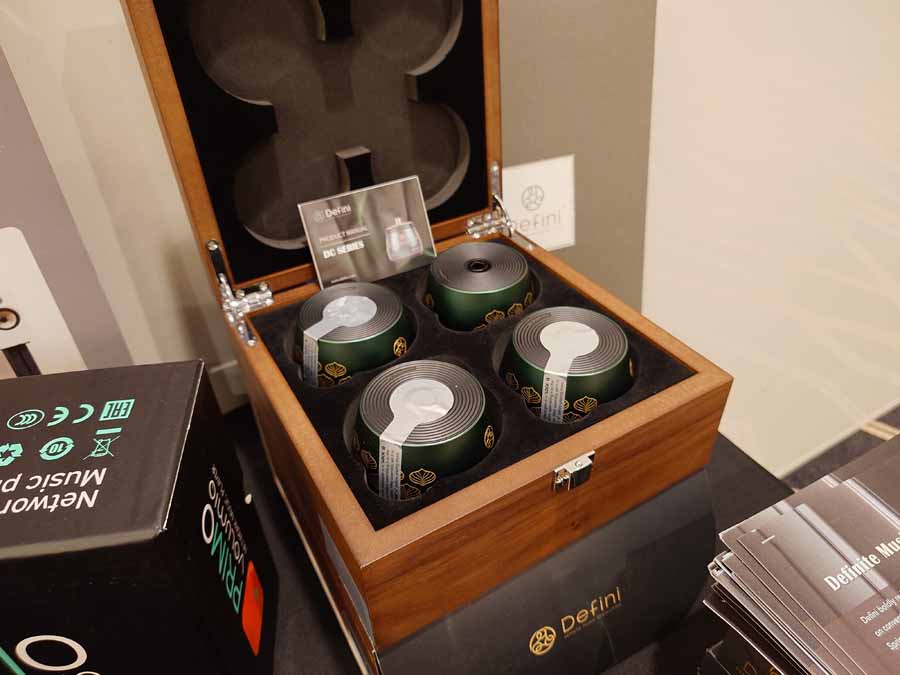
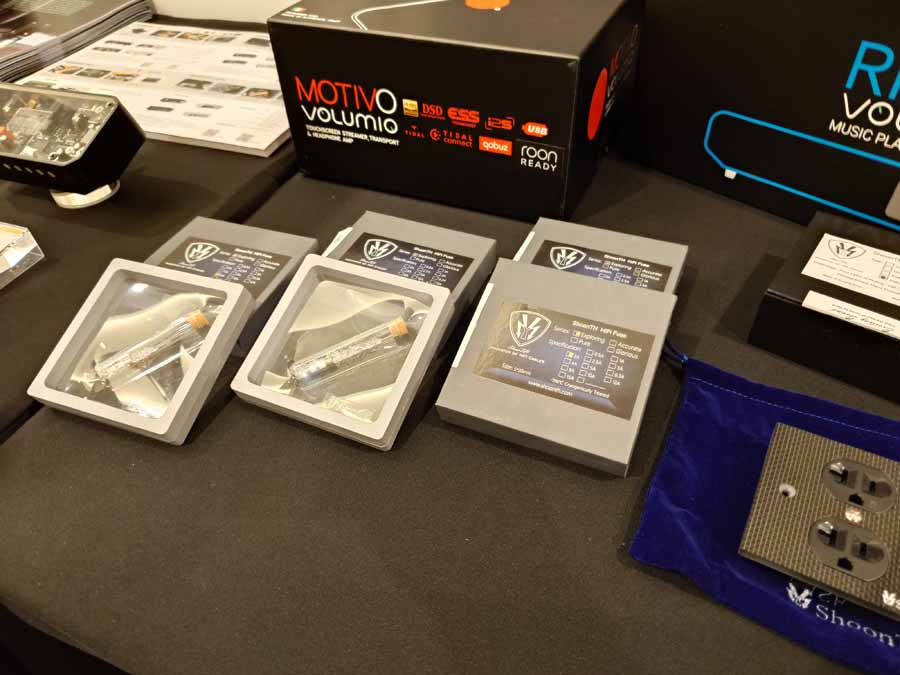
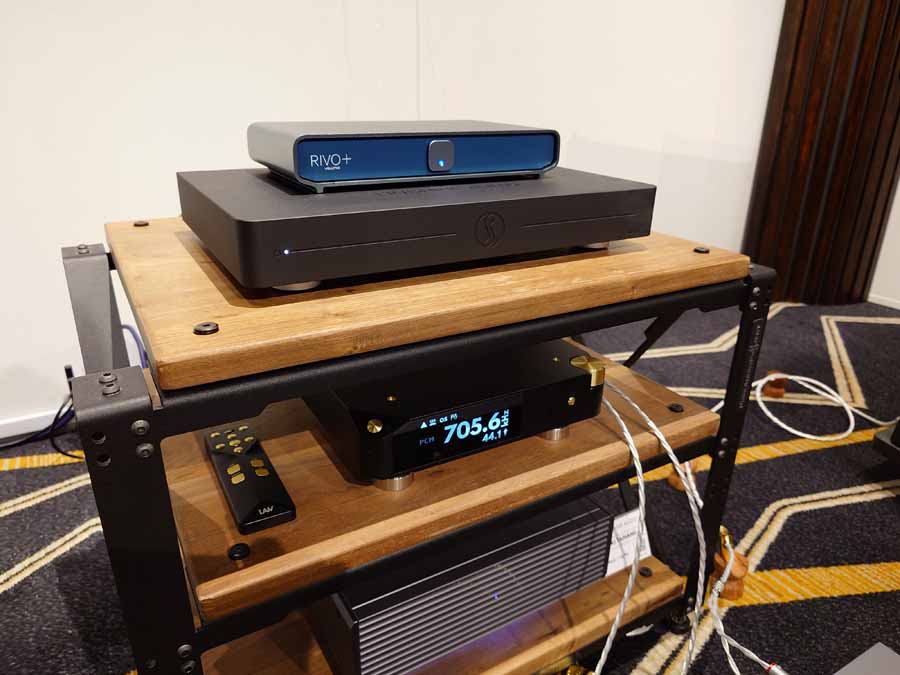

ROOM A12 CORNERSTONE AUDIO (SB ACOUSTICS, LAB12, ORIGIN LIVE, B.AUDIO, INNUOS)
This booth demonstrated indie-brand originality. The speaker of choice was the SB Acoustics Sasandu TX—a 3-way floorstander with TeXtreme drivers (29mm tweeter, 6.5” midrange, dual 7.5” woofers) that is also available as a DIY kit. I’ve heard this speaker a couple of times already, and it’s always amongst my favorites.
The B.Audio Alpha One integrated all-in-one amplifier drove the speakers with authority, paired with the Lab12 phono stage handling vinyl duties from the Origin Live Calypso turntable with Hana cartridge. For digital sources, they showcased the one built into the B.Audio Alpha One and the new Innuos network streamer, the Stream1. A practical listening session comparing streaming quality across Tidal, HiRes, and Spotify lossless playback concluded that hearing Spotify’s new lossless offering in a fresh environment was a fun experience, but HiRes downloaded files are still king.
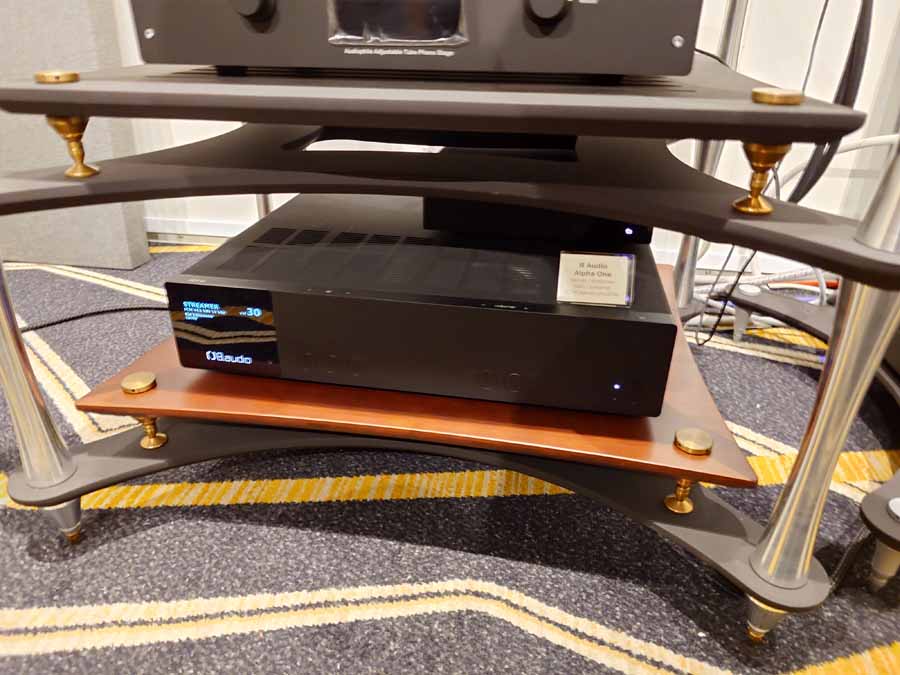
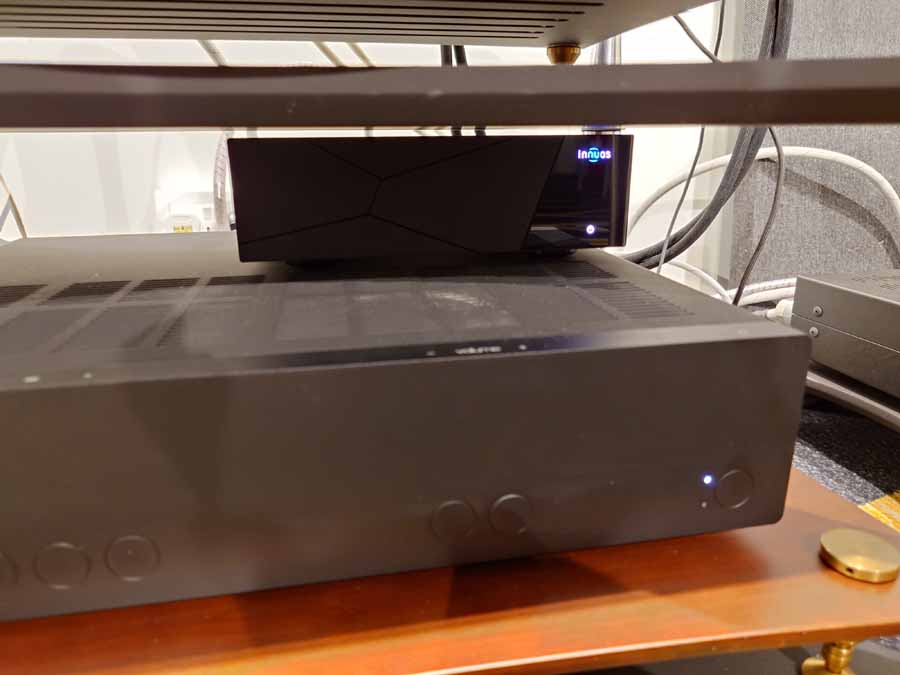
ROOM B1 OBIT AUDIO (TAD, AVALOS, FALCON)
With a delicate but well-executed setup, Obit—the Taiwanese vibration isolation specialist—made their core argument: even in flagship systems, isolation still matters. By combining their products with top-tier components from TAD, Obit made it clear that refinement extends beyond component selection. It extends to managing what those components sit on.
The TAD C1000 preamplifier, D1000 CD player, and M2500 TX power amplifier (550 watts of Class D muscle) delivered the baseline. But the conversation centered on the Avalos Brisa—a bookshelf speaker with unorthodox cabinet geometry (no parallel surfaces) and obsessive 16-layer finishing. Designed by Felix Avalos, it’s sculptural and engineered: 28 mm magnesium-ceramic tweeter, 150 mm magnesium-composite mid-bass, sealed enclosure hitting 29 Hz to 30 kHz.
The secondary Falcon 3/5A offered comparison. But the real takeaway? Obit demonstrated that vibration control transforms systems across the price spectrum. Not flashy. It is a methodical approach to improving sound quality.
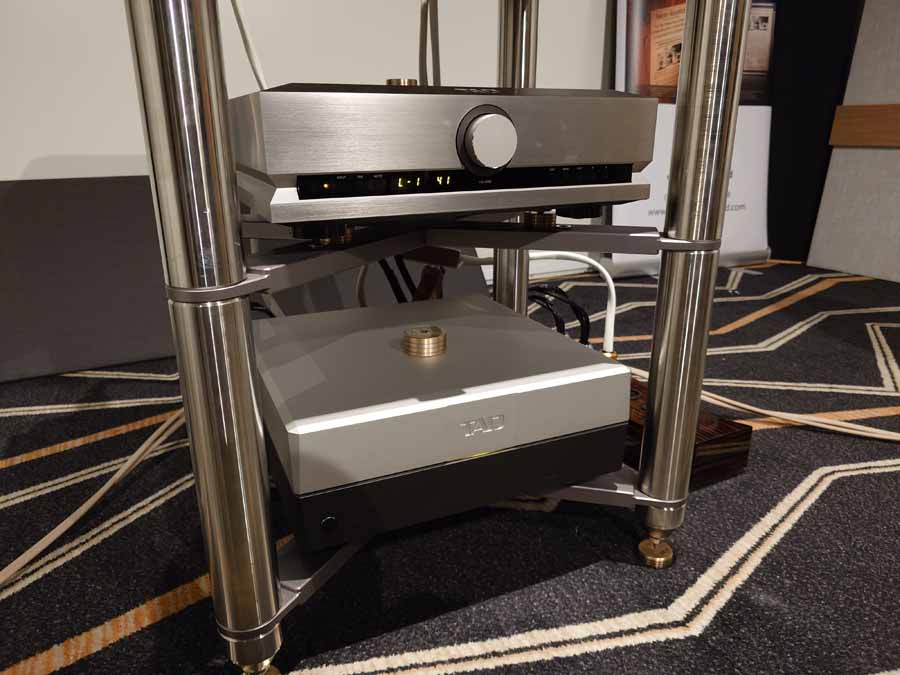
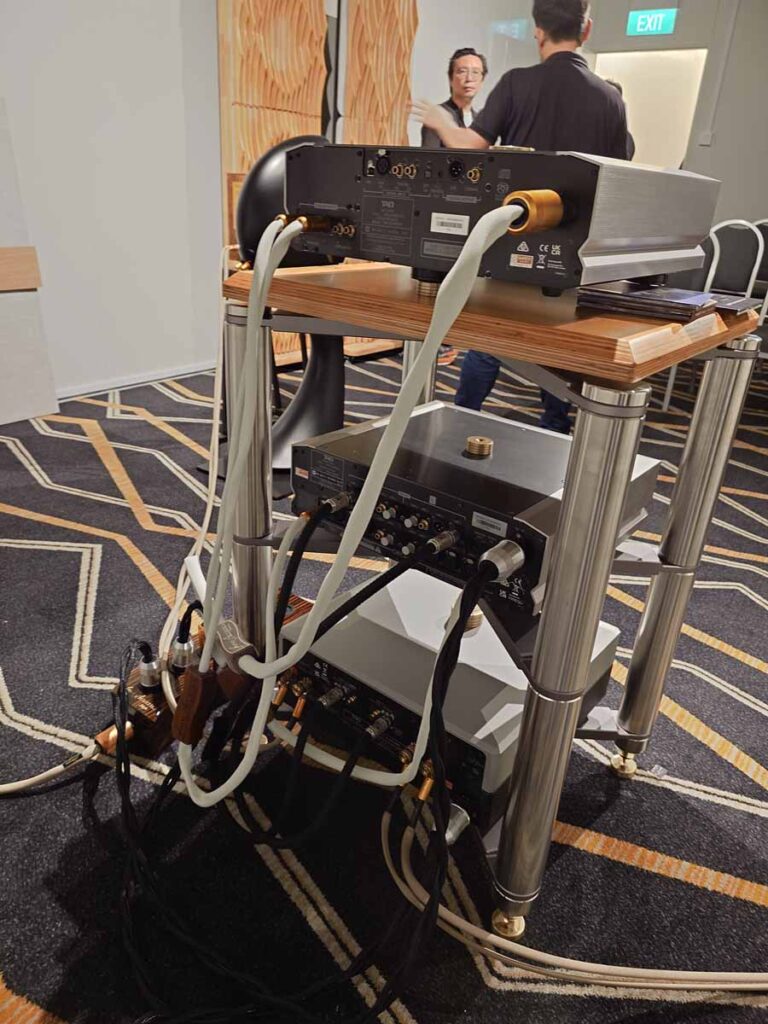
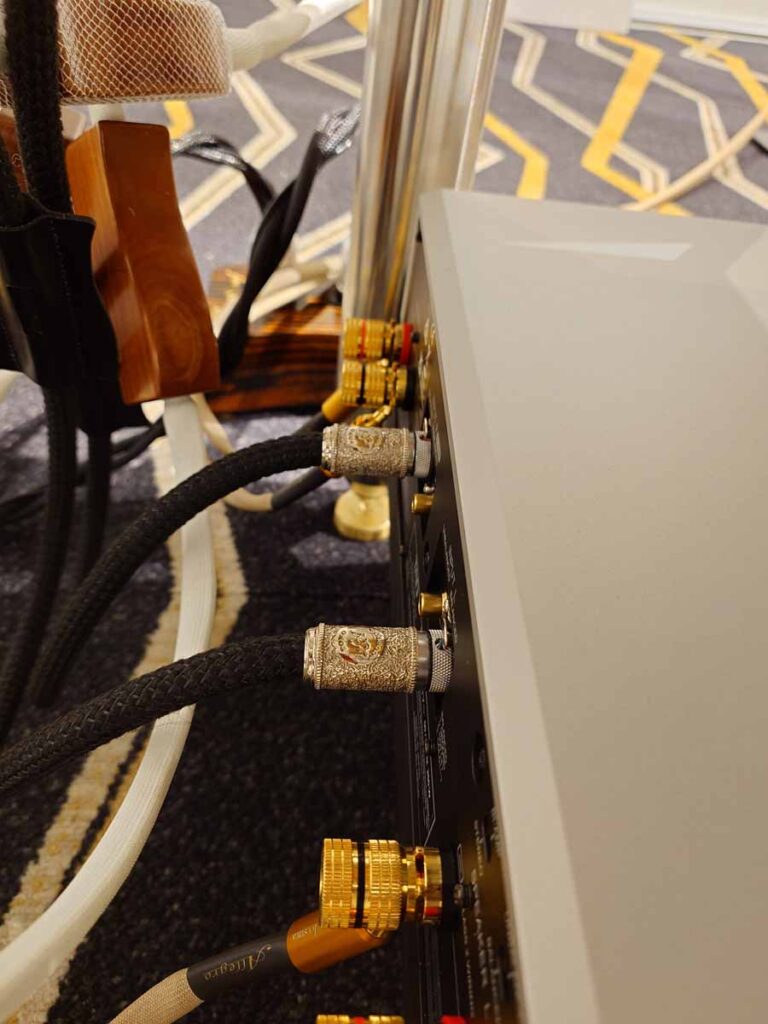

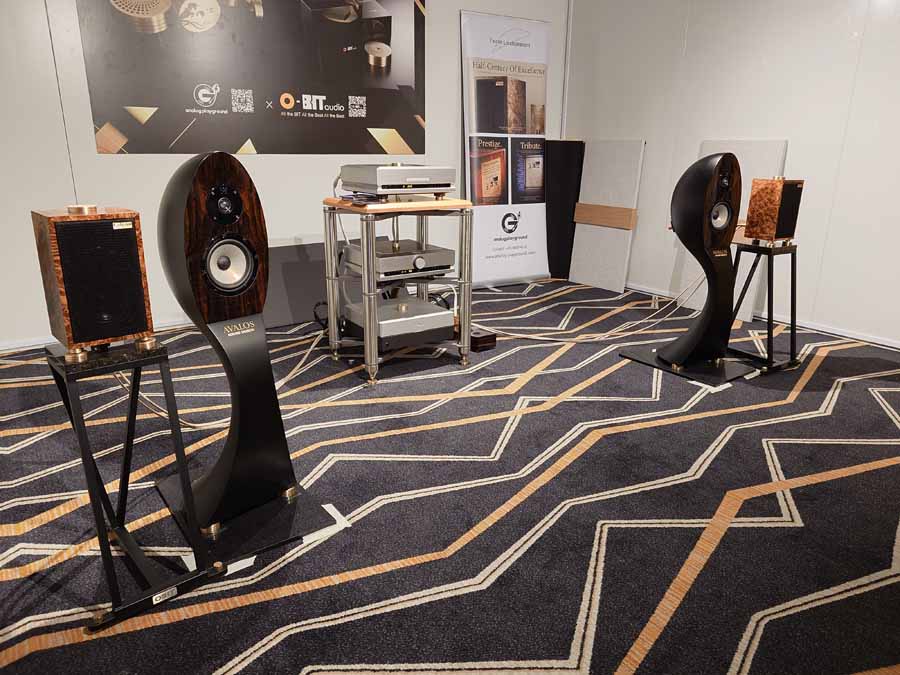

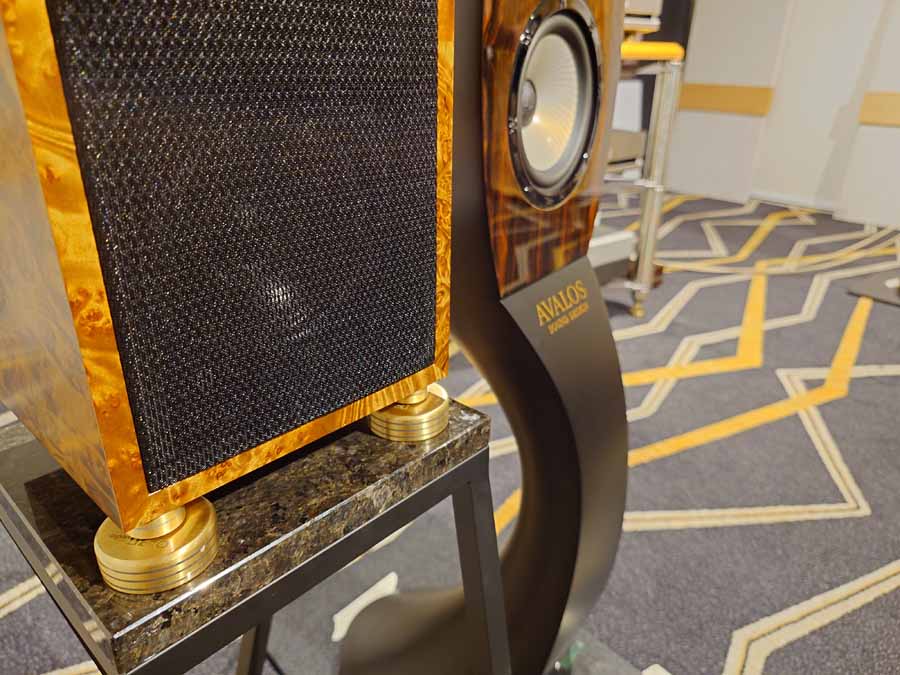
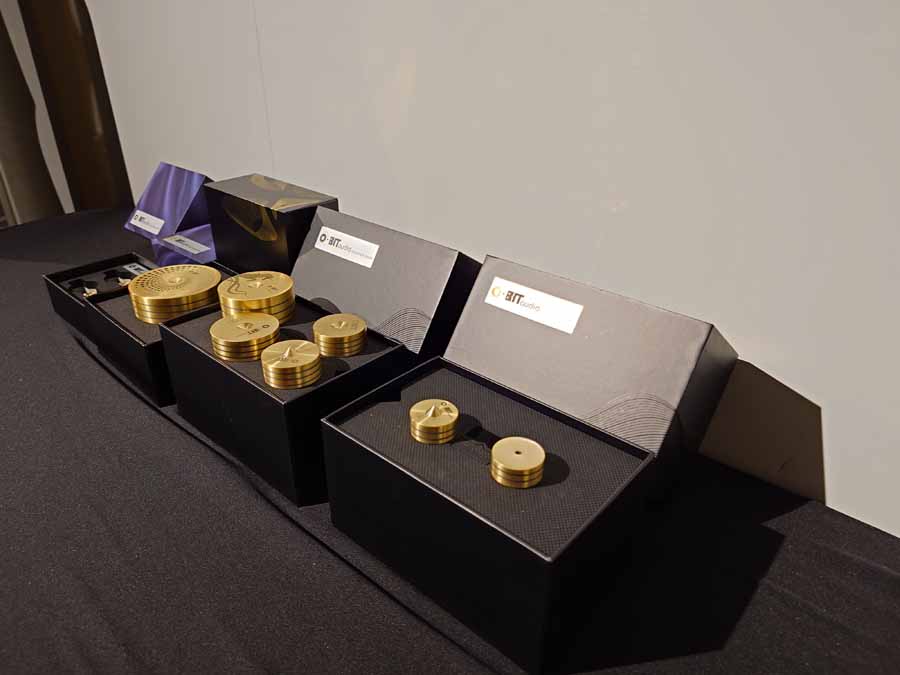

ROOM B2 VOXATIV
Voxativ brought a vertical approach to their room. Founder Inès Adler showcased the ALBERICH² ARRAY SYSTEM—a line array that stacks three wideband drivers (AF-1.9 and AF-2B models) vertically, supported by a 10” Neodymium woofer module with a 500-watt Class D amplifier beneath. The result spans 20 Hz to 33 kHz with 101 dB efficiency, meaning the system pairs naturally with the very Berliner styled T-211 integrated amplifier (12 watts of pure single ended Class-A power). The Streamer Mod .2 network streamer and DAC handled digital duties.
The philosophy is straightforward: stack high-efficiency drivers vertically for coherent soundstaging, then add active bass control. No filters, no compromise. Adler’s presence underscored that this wasn’t marketing—it was simply Voxativ’s approach to system design: think vertically, keep it simple, and let efficiency do the work.
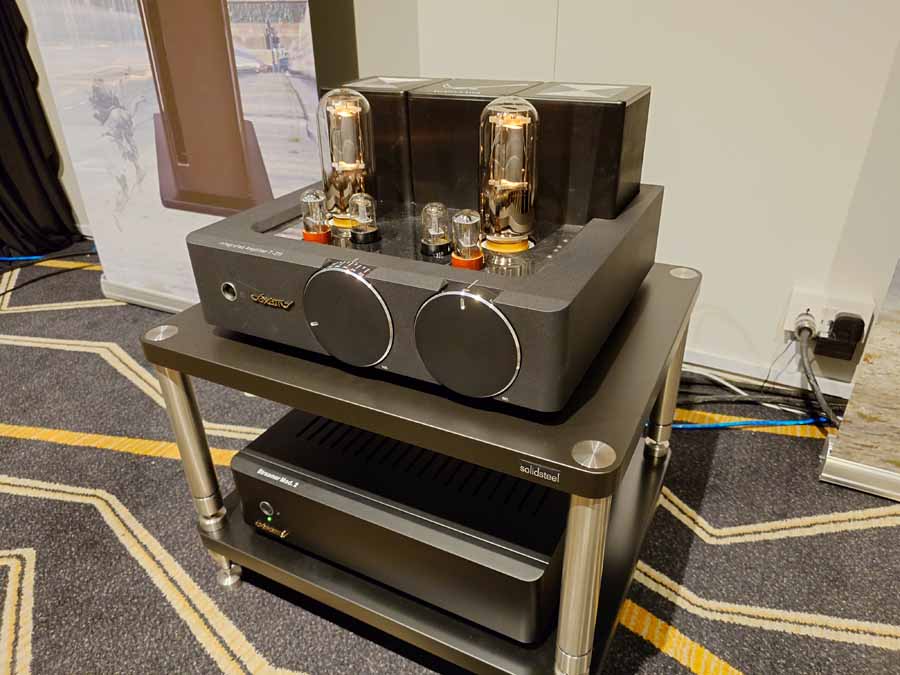
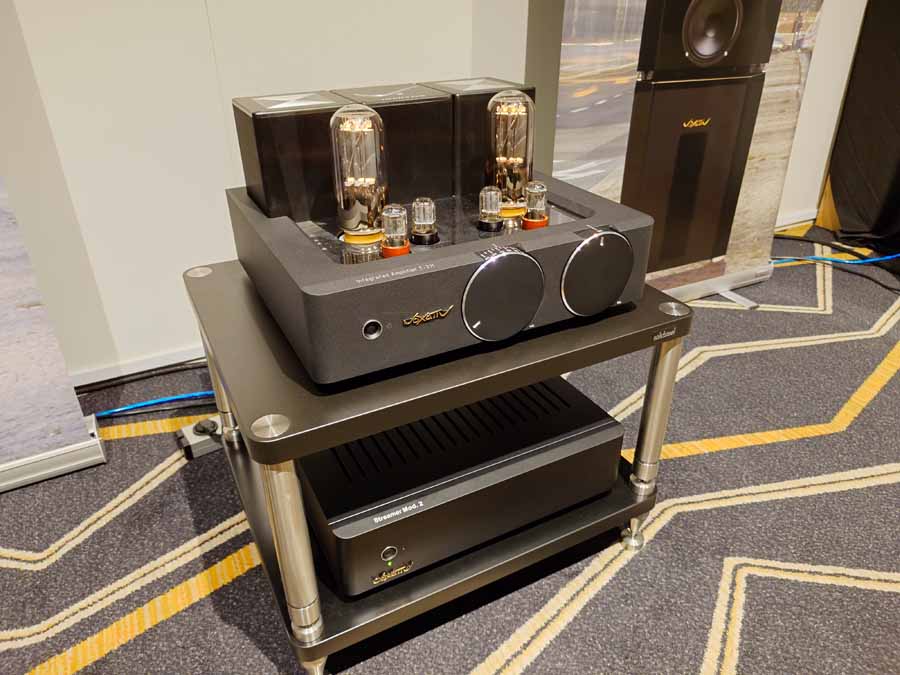
B3 MEDIAN SPEAKER
The Medien S51 bookshelf speakers arrived from Taiwan without fanfare. Handmade pinewood cabinets, 2-way design, 91dB sensitivity—compact and honest. Paired with small, concrete housed Celiah & Perah’s amplifier and streamer, connected via Sharkwire Tigershark speaker cables, the small room filled with quiet appreciation from listeners. The modest setup surprised many visitors.
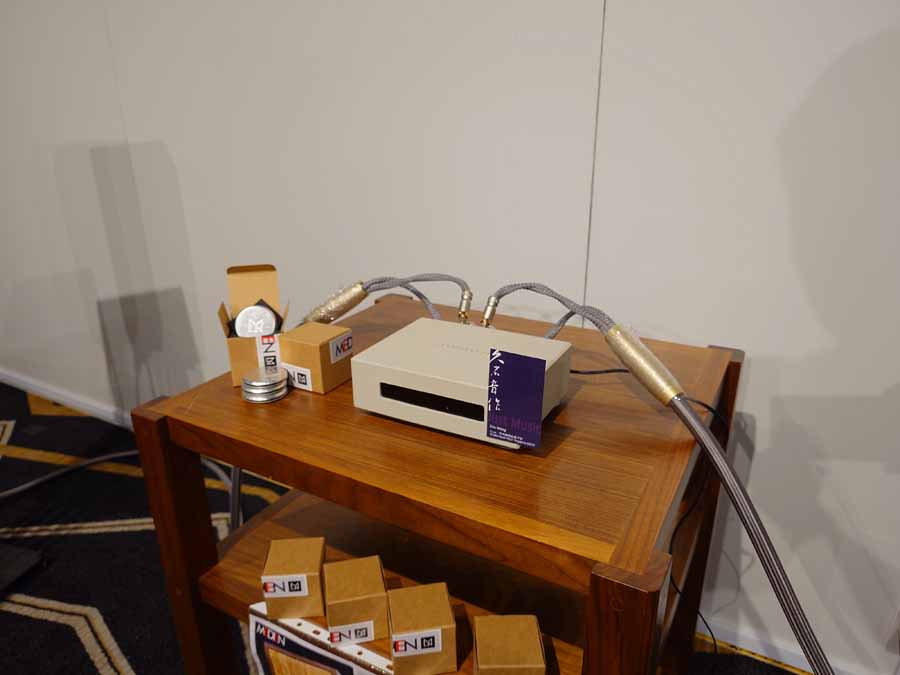

B6 REVERSE WHITE STUDIO (TAD, BAT, SIGNAL CABLE)
Reverse White Studio paired compact bookshelf speakers with some seriously muscular Balanced Audio Technology electronics. The TAD Compact Reference, driven by BAT’s REX 500 power amplifier and REX 3 preamplifier via Signal Apollon speaker cables, delivered impressive sound—and impressive volume. BAT’s REX series is built on fully symmetrical circuit design with minimal gain stages and zero global feedback, eliminating the typical compromises between power and transparency. Their fuse-less protection and auto-biasing circuits mean no fiddling required—just pure, effortless amplification. Perhaps a touch too “effortless” for the room size.

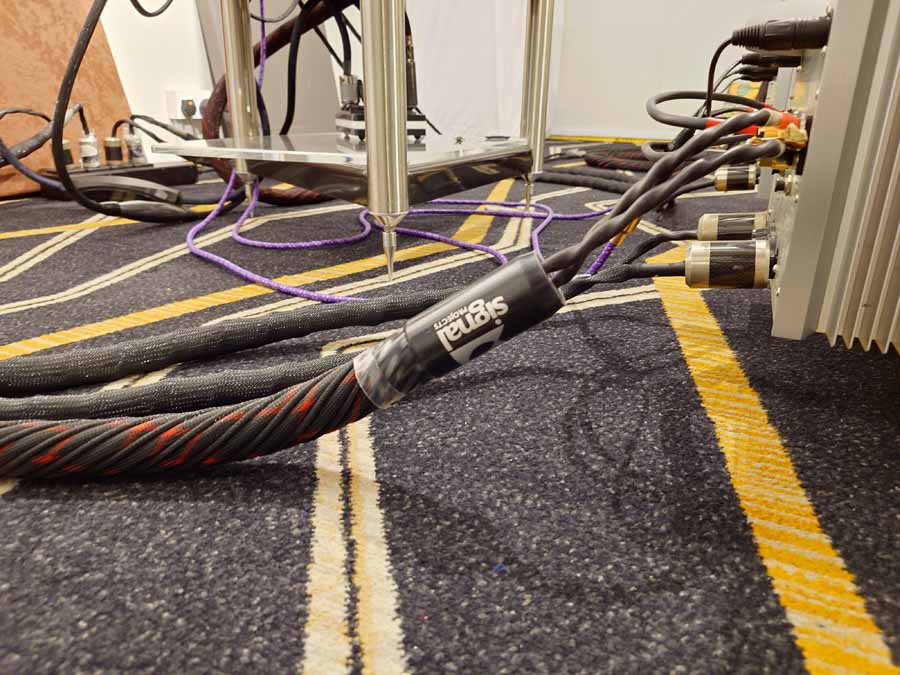


B7 AUDIO 88 (VITUS, YG ACOUSTIC, MSB, LUMIN, NORDOST)
The second room from Audio 88 introduced another compact system, yet a very different philosophy than the YG XX3 Live in Room 306. The YG Acoustic Carmel 3 didn’t need a cavernous space to command attention—driven by the newly released Vitus Audio SM-025 monoblock amplifiers, they delivered controlled, elegant sound that filled the room without overwhelming it. The supporting chain was equally impressive: the Vitus Audio SL-103 preamplifier, MSB Cascade DAC system, and the Lumin U2x network streamer, anchored by the Nordost Q-Base Reference power distributor and SRA isolation stands.
The real attraction was the SM-025 itself. Those minimalist Danish white monoblocks—sleek, unfussy, pure engineering- Class A/AB topology pushing 100 watts pure Class A with zero global feedback, custom transformer, 180,000μF capacitor bank per channel. Not just specifications; it’s restraint paired with unquestionable authority. The cherry on top was that Hans Ole – founder and designer of the Vitus products – was present, so we could dig into the design philosophy behind his gear, which led naturally to broader questions about the industry’s future.
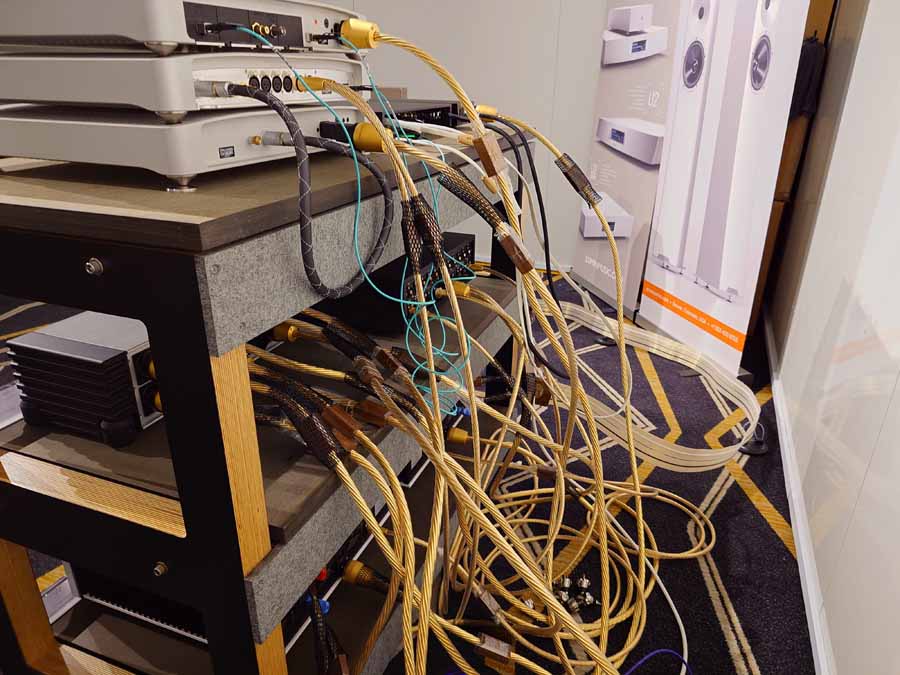
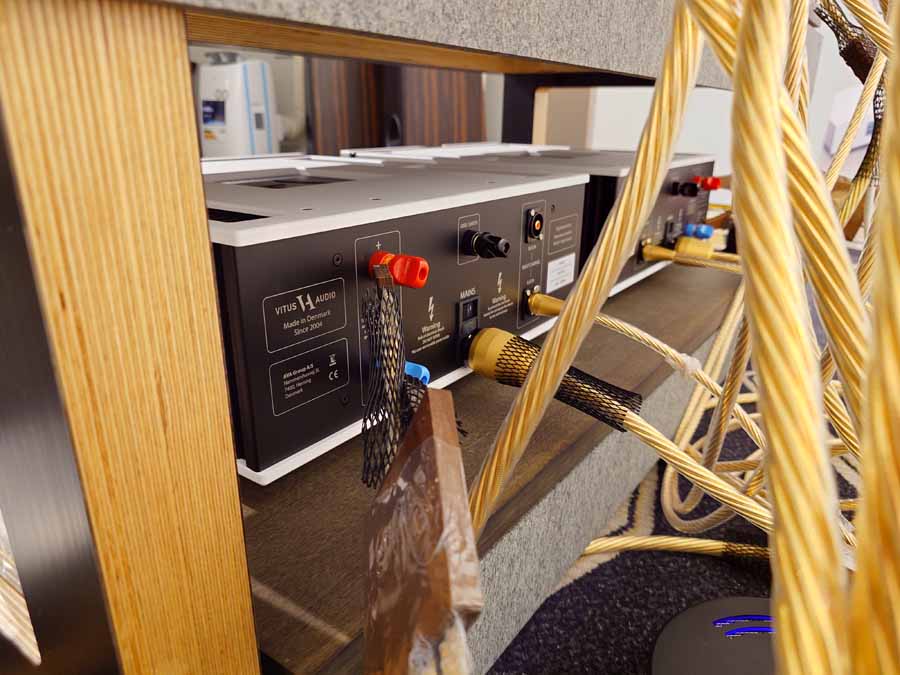
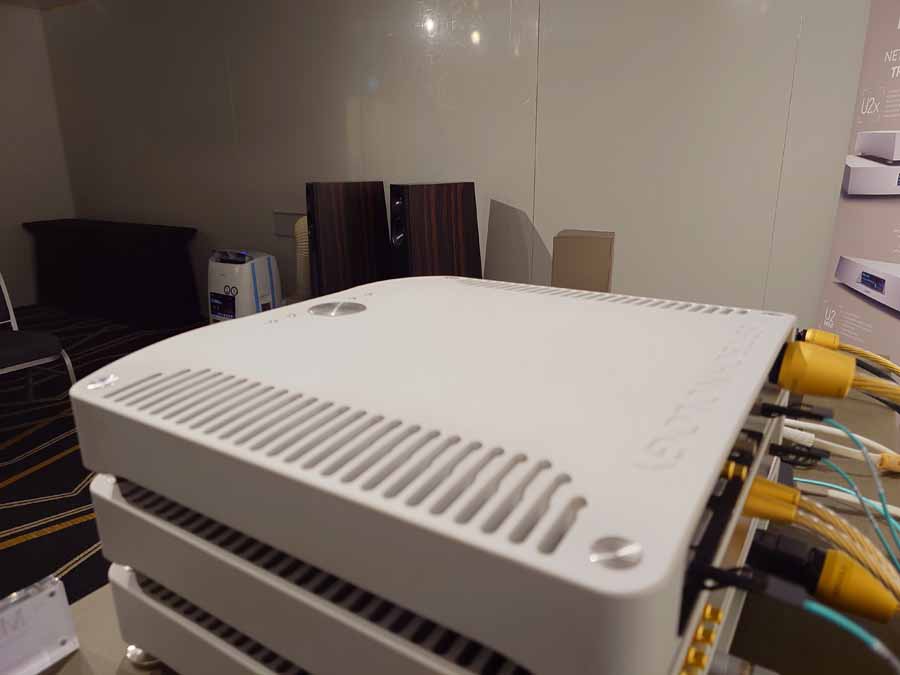
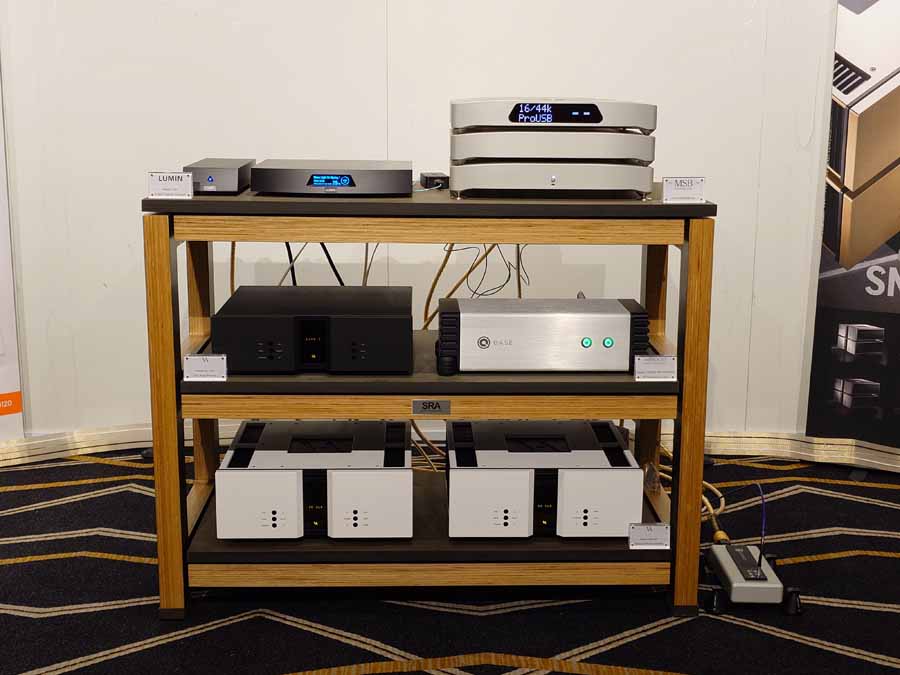
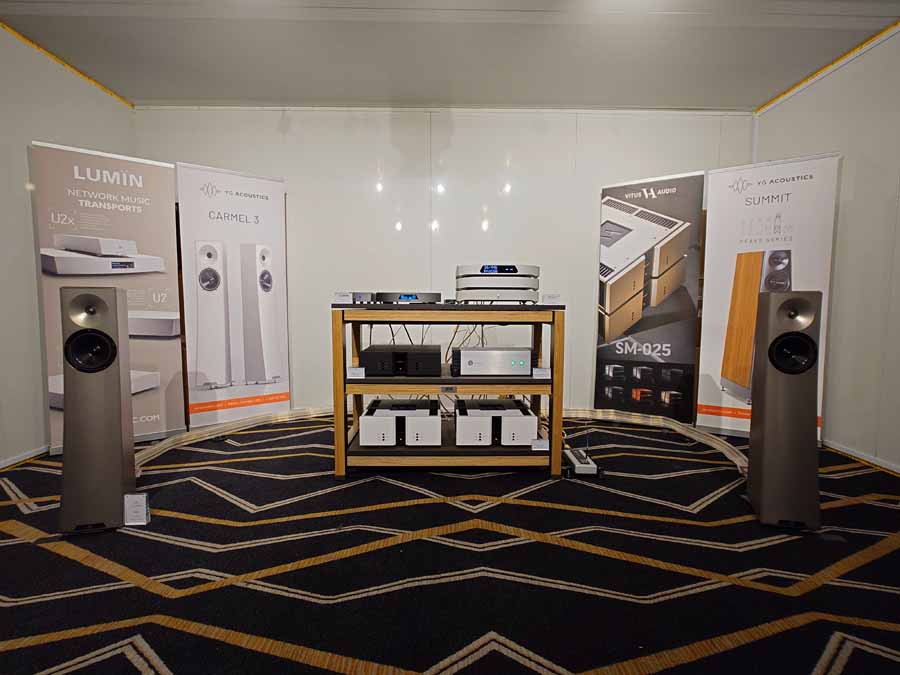
B8 MOD AUDIO (THALES, EMT, ROUGE AUDIO, METRONOME, PLIXIR, YG ACOUSTIC)
Mod Audio’s room was a masterclass in understatement. No flashy appearance, no unnecessary flourish—just carefully considered components speaking through action rather than words. The YG Hailey 3.2 speakers, Rogue Audio M-180 power amplifier, and Metronome Le Player 4+ digital player formed the backbone, but the real conversation starter was the Thales turntable.
Micha Huber walked me through the Thales philosophy, and it clicked immediately: this is watchmaking applied to analogue playback. At the heart of the Reference turntable sits the recently patented centrifugal governor—a mechanical solution that keeps driving and braking torque in constant balance without a single electronic controller interrupting the signal. The result? Unprecedented timing stability during playback. No electronic servo trying to correct what shouldn’t need correcting in the first place.
After the show, I read up about it further, as I got impressed by the engineering behind it. The curved sub-platter with hard paper decoupling, a main bearing built from tooling steel and sintered bronze (old-school craftsmanship guaranteeing decades of maintenance-free operation), and a battery power supply that elegantly disconnects the turntable from the grid during listening. No hum, no noise floor pollution—just the turntable doing what it was designed to do.
Paired with the Magnifier phono preamp—inductive RIAA implementation, zero capacitors in the signal path—and the equally elusive JPA66 MKIII preamplifier (roughly ten made annually), this room proved that sometimes the most confident audio designs are the ones that refuse to shout about themselves.
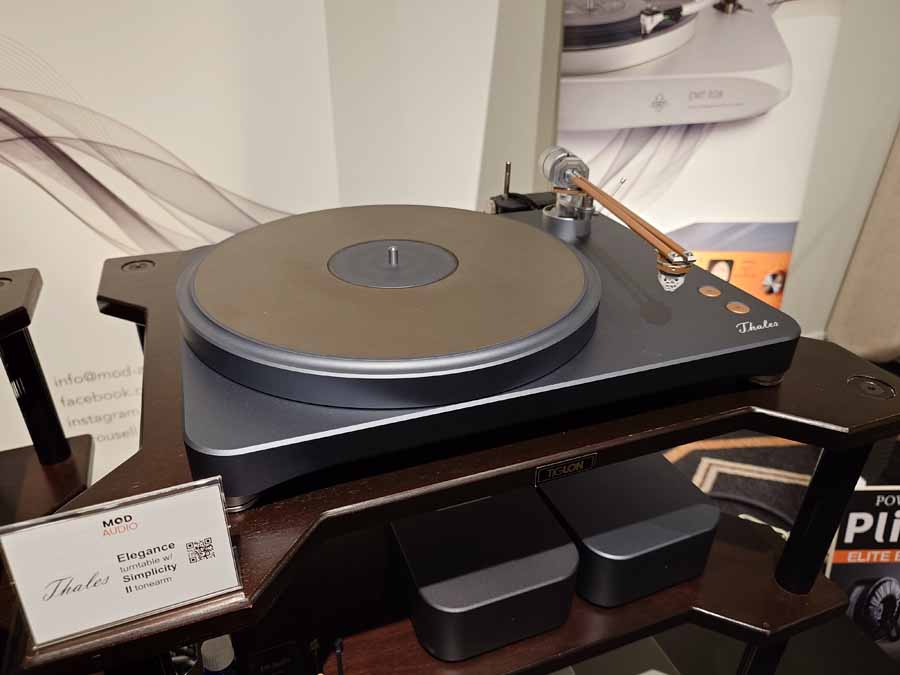
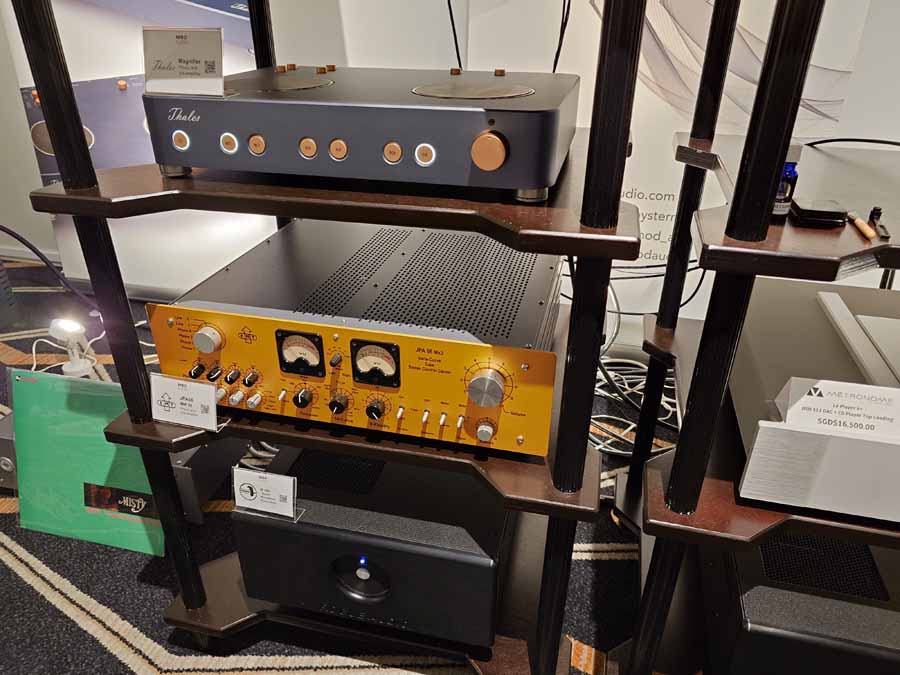

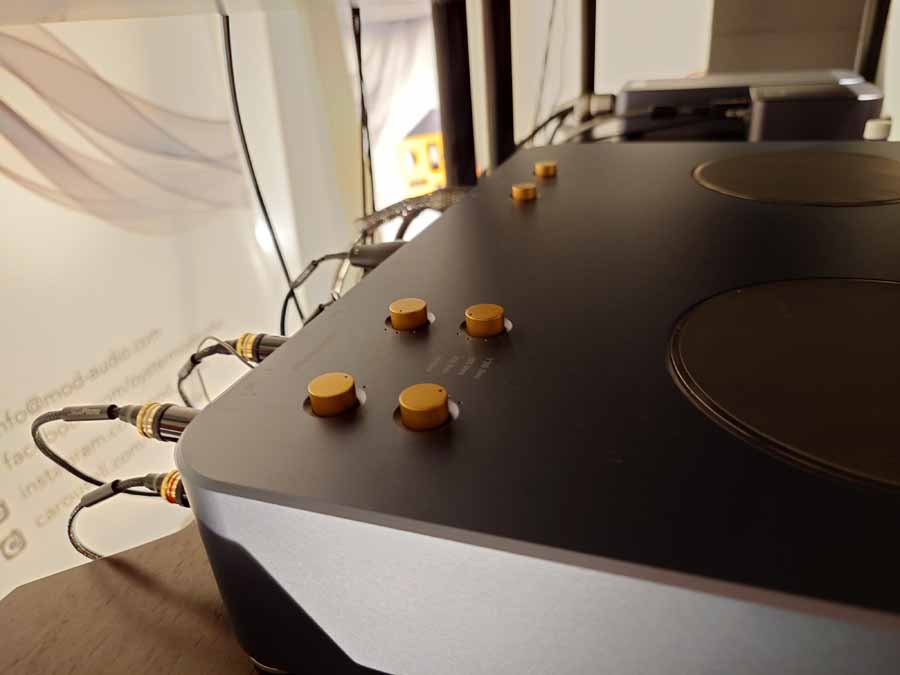

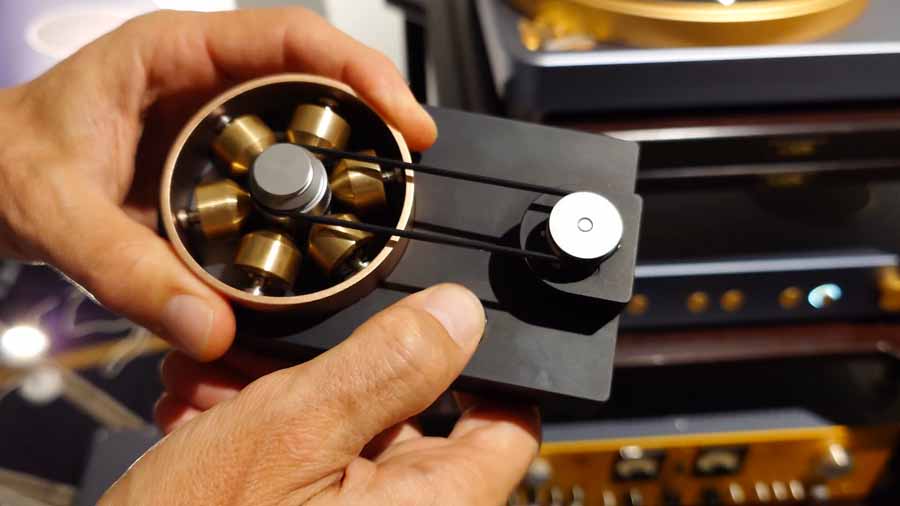

FINAL THOUGHTS
My second visit to Hi End Asia, and Singapore, felt notably different—and better. The venue provided actual breathing room, exhibitors clearly invested effort into thoughtful system building, and the curation of everything from gear to music felt intentional. No more demo clichés on loop. Instead, rooms featured a well-curated playlist, intimate concerts featuring Annette Åsvik and Anne Bisson, and a refreshing cross-cultural arc through Kiva and Zhong Zhigang—an Asian perspective with Western influence.
That mix shouldn’t be underestimated. Hi End Asia Singapore’s position as a natural hub for high-end audio in Asia becomes clearer each year: serious exhibitors, knowledgeable staff, and an audience that actually cares about the music.
The venue has room to grow, the community has momentum, and the foundation is solid.
Come back next year? You bet, HiFi PiG will be there to snoofle out the best in HiFi.
Read our Hi End Asia Singapore 2025 Report Part One here
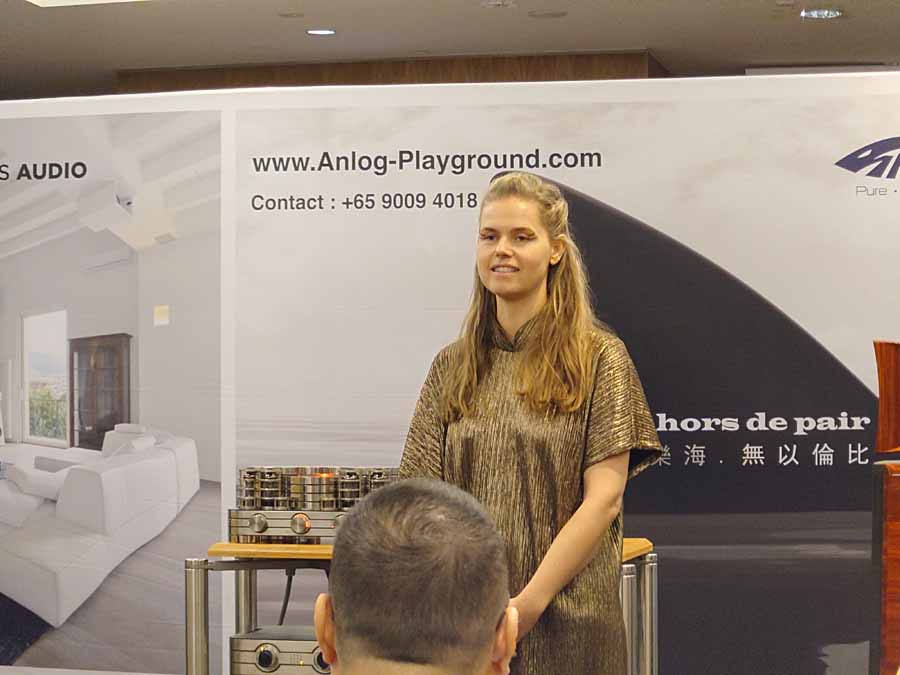

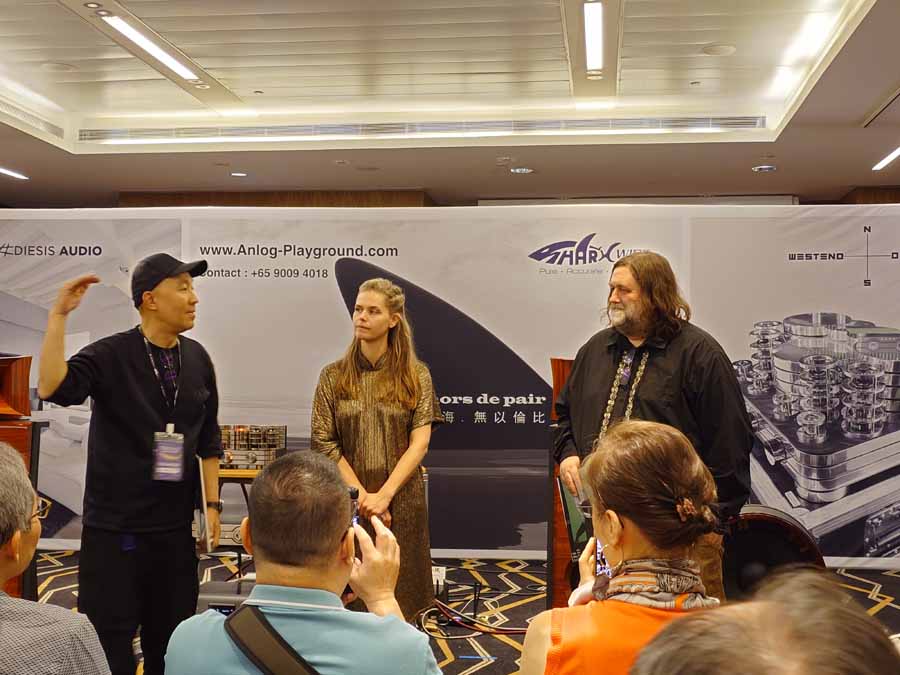
Please note, all content and photos are the copyright of HiFi PiG Magazine/Big Pig Media LLP and must not be copied or reproduced in any way without the prior, written consent of the editor.

Gyula Weeber


























































